- Brands
- Latest Devices
- Popular Devices
- Related Devices
- Partner Sales
iPhone 16 Pro Max
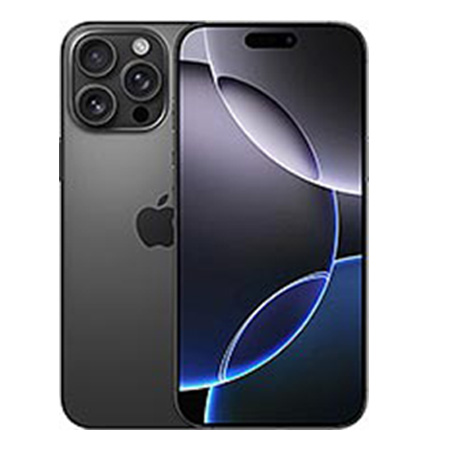
- Released, 2025-04-04
- 227 g (8.01 oz)
- Apple A18 Pro (3 nm)
- 1320 x 2868 pixels, 19.5:9 ratio (~460 ppi density)
6.9
1320x2868 Pixels
48 MP
2160p
8GB RAM
Apple A18 Pro
4685mAh
PD2.0 25W
Please select at least one products to compare.
What do you think of the Poco F7 Pro and Poco F7 Ultra?
The Poco F series has earned a reputation for offering flagship performance on the cheap. However, the prices of everything have been going up and that has affected even Poco. Also, the brand is moving into a more premium direction and today we didn’t even get a vanilla F7, just a Pro and an Ultra.
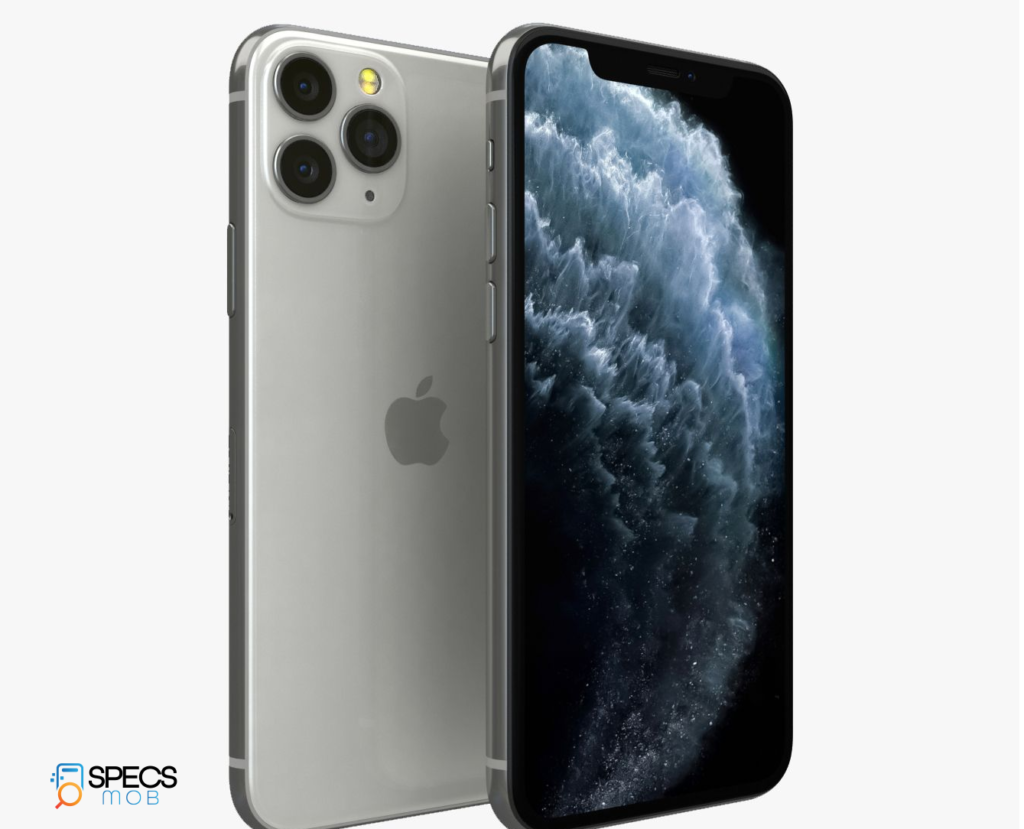
Here is a price comparison between the Poco F6 generation and the new models. As it stands today, the cheapest entry into the F7 series is $500/€600. And yes, the global pricing of the Pro model is the same, but Europeans are looking at a €100 price bump.
Let’s start with the Poco F7 Ultra, the brand’s first Ultra phone and its first attempt at an all-out flagship. The Poco F4 GT (2022) was the last to launch with the then-current Snapdragon chip. Since then, the F-series picked older chips but got them cheaply. The F7 Ultra is a return to form with the best Android chipset of today, the Snapdragon 8 Elite.
That’s not all, Poco added a telephoto camera, a 50MP 2.5x unit with a floating lens that also does tele-macro shots, and included an ultra-wide camera that’s more than an afterthought (32MP).
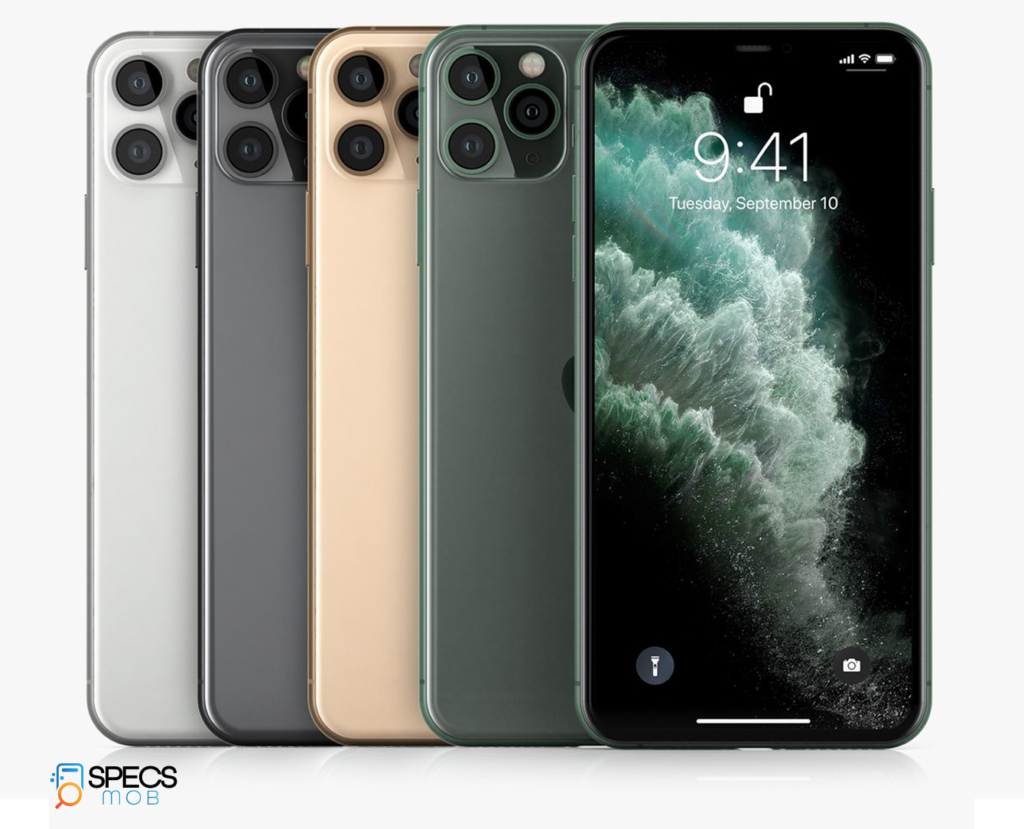
There are other goodies like wireless charging (50W) to go with the 120W wired charging, plus a proper IP68 water resistance. This is a flagship and while it’s expensive for a Poco, it’s relatively cheap among its Snapdragon 8 Elite peers.
Let’s have a look at some of them. The OnePlus 13 starts at $900/€1,000 for a 256GB unit. The Galaxy S25+ starts at $1,000/€1,150. A Realme GT 7 Pro is normally €800.
You may argue that we should be comparing this to the likes of the Galaxy S25 Ultra, Xiaomi 15 Ultra and others, but those are even pricier and the Poco F7 Ultra doesn’t have the camera to compete with them, anyway.
The Poco F7 Pro is the more affordable variant and it’s not a small gap, it is $150/€150 cheaper than its Ultra sibling. So, you save some money, but you lose performance – the Pro is powered by the Snapdragon 8 Gen 3. Most of the new camera hardware is gone too, the Pro only has an 8MP ultra-wide to keep the 50MP main company. The battery is larger, 6,000mAh vs. 5,300mAh, but there is only 90W wired charging, no wireless.
The OnePlus 13R makes a similar choice and uses the 8 Gen 3 chipset to save some money. A 256GB unit goes for $600/€750, putting it closer to the Ultra pricing than the Pro. No Snapdragon, but the Samsung Galaxy S24 FE has an MSRP of $710/€660 for a 256GB model. The Honor 200 Pro uses the Snapdragon 8s Gen 3 instead of the regular 8 Gen 3 and goes for €800 for a 512GB model. These prices are without any discounts and discounts are easy enough to find – and note that the Pocos have early bird pricing too, if you buy before April 10.
Apple IPhone 12 Pro Review
Introduction:
This year, Apple is offering potential customers more options than ever. We have already examined the iPhone 12, and now it’s time to look at the 12 Pro. In addition to featuring double the storage, a stainless steel frame, and different colors compared to the 12, the upgrades for the 12 Pro are primarily related to the camera. It includes a dedicated telephoto camera with 2x optical zoom, a LiDAR Scanner for augmented reality uses and low-light focusing, and it is capable of capturing portrait photos with Night mode. This isn’t the longest list of improvements we have encountered, so deciding between these two iPhones will be quite challenging.
The compilation of new features is larger, particularly in contrast to the iPhone 11 Pro. A quicker processor, 5G connectivity, an expanded display with enhanced shatter resistance, Dolby Vision video recording, MagSafe compatibility, an expanded display with enhanced shatter resistance, and the latest LiDAR are all part of it.
Most importantly, however, is the new design that Apple is introducing with the 12th Series, which immediately undermines the modernity of all previous iPhone models.
Specifications of the Apple iPhone 12 Pro:
- With its polished stainless steel frame, oleophobic Ceramic Shield front, matte glass back, and IP68 dust and water resistance rating, the chassis is a fantastic example of engineering. Available colors consist of silver, graphite, gold, and pacific blue. Weighs 189 g, with dimensions of 146. 7 x 71. 5 x 7. 4 mm.
- Display: 6. 1″ Retina XDR OLED display offering touch sensitivity at 120 Hz, 600 nits brightness, 460 ppi resolution, and a pixel count of 1170 x 2532. HDR10, a wide color gamut, and support for Dolby Vision. Real Tone.
- Chipset: Hexa-core (5nm) Apple A14 Bionic chipset (2×3. 1 GHz Firestorm + 4×1. 8 GHz Icestorm with 3. 1GHz Turboboost) equipped with a 16-core Apple NPU, 4-generation four-core Apple GPU, and Apple CPU
- Memory: 128/256/512GB of internal storage; 6GB of random-access memory
- triple 12MP rear camera: a 26mm wide-angle, f/1. 6, OIS, Dual Pixel AF camera; a 13mm ultrawide-angle, f/2. 4, 120-degree field of view; a 52mm telephoto, f/2. 0, OIS, 2x optical zoom; and a dual-LED slow-sync flash. Night Mode, Deep Fusion and Smart HDR 3.
- Wider dynamic range, spatial sound, OIS + EIS, Dolby Vision, and video recording at 2160p@60/30 fps and 1080p@30/60/120/240 fps
- Front camera: Dual camera: 3D TOF camera, 23mm 12MP f/2. Deep Fusion, Smart HDR 3, and Night Mode; two front-facing cameras with HDR mode. Video recording at 2160p@60/30fps and 1080p@30/60/120fps provides a broader dynamic range, spatial sound, and EIS.
- Wi-Fi a/b/g/n/ac/6, Bluetooth 5. 0, dual SIM, 5G, 4G, GPS with A-GPS, GLONASS, GALILEO, and QZSS, NFC, and an Apple U1 chip for ultrawideband connectivity.
- 2,815 mAh battery featuring 15 Qi wireless charging (MagSafe) and 20W rapid charging
- Miscellaneous: a special TrueDepth camera for face ID, a taptic engine, and two speakers
Furthermore, the appeal of the iPhone 12 Pro is lessened by Apple’s questionable decision to restrict camera hardware enhancements to the iPhone 12 Pro Max. Since Apple is preventing users from accessing the new 12MP sensor with larger pixels and sensor-shift stabilization unless they buy the 12 Pro Max, not all consumers will be inclined to choose a larger phone. We think that instead of relying on last year’s camera technology, the iPhone 12 Pro ought to have camera hardware of the same quality.
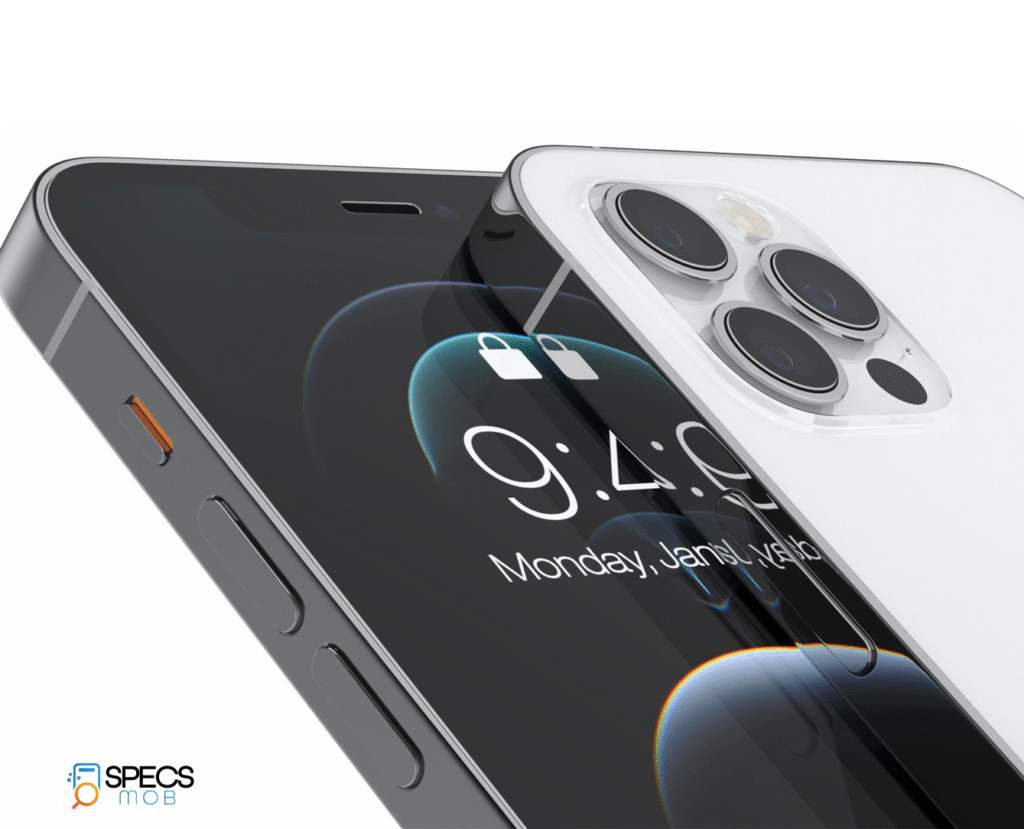
Finally, Apple announced that they would discontinue the inclusion of a charger or headphones with this phone, which is priced at over $1,000, in one of the most controversial decisions in the industry.
The packaging for this year’s iPhone 12 Pro is one of the most minimal we have ever encountered for a smartphone. Only the phone itself and a USB-C/Lightning cable are provided. There are no chargers or headphones included. Apple assumes that you already possess these items or, even better, buy them separately.
Additionally, there is a small sleeve within the package that holds an Apple logo sticker along with the SIM ejection PIN. Since we already possess those items, Apple ought to have skipped the hassle of including them. In fact, there’s no requirement for a box either; simply encase the iPhone 13 with bubble wrap.
Well, we’re a bit disappointed, but the price of the iPhone 12 Pro is also a little high. Let’s take a look at what it has to offer for our hard-earned cash in the pages ahead.
Design:
The iPhone 12 Pro may be tempting due to its enhanced features, but the Series’ redesigned appearance will have a major impact on many iPhone 12 Pro purchases. Some of us on the team share this attitude.
The iPhone 4 and 5 had legendary designs. We have been waiting for their restoration ever since seeing it replicated on iPads, and it is now taking place. This redesign of the iPhone Series 12 is more likely to be remembered than its much-heralded features, such as 5G.
The new Ceramic Shield glass, which is made by Corning and has microscopic ceramic crystals added to make this year’s screen glass more durable, is the centerpiece of the revamped design. The new screen glass is said to be four times more breakproof than that of the iPhone 11, according to accounts. The drop test videos that all of these fans have posted online suggest that the new iPhones are far more shatter-resistant.
The Ceramic Shield also features Apple’s oleophobic coating for improved smudge resistance and is ion-strengthened against scratches. Fingerprint smudges are very easy to wipe away, even if scratch-resistant screen glass does not exist right now.
The rear panel is gorgeous, featuring the same frosted glass as the iPhone 11 Pro in a flat design. The back panels of the iPhone 12 series are not made of the same Ceramic Shield substance. They are just as resistant to cracking and scratches as the iPhone 11 because they are the same as the ones from the year before. Although it differs from what you get in the front, it’s not all that awful.
However, the frosted layer on the back glass provides better protection against scratches. Based on our experience with the iPhone 11 Pro, objects in your pocket can scratch it, but these scratches are easily removed with a bit of rubbing and wiping.
The back panel of the iPhone 12 Pro is quite different from that of the iPhone 12. It has a frosted panel and a shiny, mirror-like camera square. The new flat frame, which replaces the iPhone 12’s lighter and frosted aluminum chassis with this stunning, shiny stainless steel piece, is also in the same vein. You cannot purchase an iPhone with a completely matte finish this year.
The steel frame of the iPhone 12 Pro receives luxury points because it gives the gadget a premium feel. The 12 Pro, for the record, is obviously flat and capable of standing upright on its own. However, the frame’s extreme glossiness draws fingerprints and is hard to keep clean. It develops ugly smudges after only 30 minutes of usage.
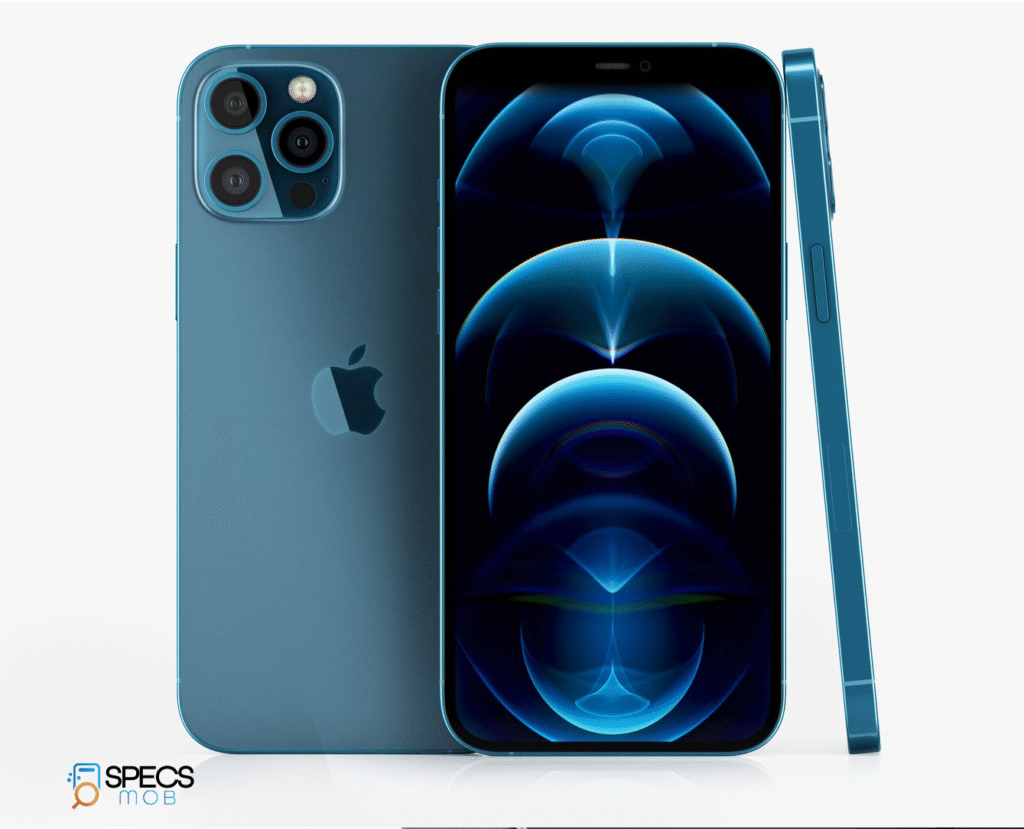
In addition, stainless steel is heavier than aluminum. The iPhone 12 and 12 Pro are the same, with the exception of the extra telecam and the LiDAR scanner. But we believe that the iPhone 12 Pro is 35 grams heavier than the regular iPhone 12 because of its frame.
The frame’s lack of grip is its worst attribute, last but not least. It can be difficult to pick up the iPhone 12 Pro from your nightstand or desk when it’s not in a case, and you run the risk of dropping it in the process. It’s so awesome!
Despite the iPhone 12 Pro’s IP68 certification for dust and water resistance, Apple has further enhanced its water protection with the new design. The iPhones can now endure water depths of 6 meters for 30 minutes with certainty. The Ceramic Shield and this make the 12th generation one of the strongest non-rugged smartphones on the market.
The 6.1″ Super Retina XDR OLED screen of the Apple iPhone 12 Pro is a bit bigger than the one on the iPhone 11 Pro.The notch remains big despite the tiny bezels.
One of the most persistent rumors this year was the 120Hz ProMotion display, which never came to pass. It’s depressing for reasons we’ll never know why, but even the more expensive Apple flagship models continue to have 60Hz displays. That 5G connection would have been a welcome upgrade, and we would have been happy to swap it for 120Hz. It is what it is.
The same characteristics as the iPhone 11 Pro are found inside that hideous notch: a 12MP selfie camera on the right, a stereo speaker/earpiece in the middle, and a Structured Light 3D camera on the left. Face ID is presently your only option for biometric security, and it seems that Apple has no intention of introducing a next-generation Touch ID sensor. It’s really too bad that there’s only a face unlock feature available, given how frequently we are required to use masks.
The screen is entirely flat. Not even a 2.5D finish can be seen on the edges. The rear panel in our instance is made of frosted graphite and is also flat, giving it a great appearance. The Apple logo, as always, is a small mirror.
The somewhat protruding camera square has three 12MP cameras: primary, telephoto, and ultrawide. Additionally, the LiDAR sensor and dual-LED flash are located here. The square glass at the rear is so polished and has rounded corners that it nearly resembles another mirror.
Each of the three snappers is encircled by miniature metal rings, and a millimeter or so protrudes from the common glass. Finally, sapphire glass components that protrude about half a millimeter outside the rings safeguard each of these snappers.The phone’s camera system doesn’t seem like a big bulge and shakes less because of all this meticulous planning.
Since the iPhone’s robust sapphire glass components are the ones that touch the surface you set it on, there is a considerable risk of harming glass or other glossy surfaces, let alone other gadgets. As a result, even though the cameras are well protected, be mindful of where you put your iPhone. Don’t lay it on top of other phones, of course!
Apart from the SIM tray being shifted to the left, the frame may have a different design, but it otherwise has no surprises. On the left side are the flat volume keys and the traditional silencer switch. The Lightning connection, the second stereo speaker, and the mouthpiece are at the bottom, while the Side/Power button is the only one on the right.
The iPhone 12 Pro is the same size as the iPhone 12, but 3mm taller than the iPhone 11 Pro. Even if it weighs the same as its predecessor, it is a bit heavier than the iPhone 12. The redesigned frame makes it feel somewhat safer and fits better in the hand than the iPhone 11 Pro.
In contrast to the iPhone 12’s matte frame, it doesn’t have the same sense of security in the hand. Despite the sharp borders, the glossy frame blends perfectly with the glass and has little to no traction. You have to make a case for this amazing number, even if it’s sad. I’m sorry.
We really like the angular form and flat surface, and we certainly appreciate the enhanced water resistance and shatterproof glass. It is most likely an amazing technological achievement that warrants more research. However, since the iPhone 12 Pro’s cons far outweigh its pros, we think it merited a more thorough frame polish than this shiny mess.
Display :
The iPhone 12 Pro has a 6.1-inch OLED screen with sharp, clear quality thanks to its resolution of 1,170 by 2,532 pixels and 460 pixels per inch. It has Ceramic Shield protection and an oleophobic coating for increased smudge resistance. The screen supports HDR10 and Dolby Vision. All well-known streaming services offer high-resolution HDR video.
The Apple iPhone 12 Pro display has the Taptic Engine-powered Haptic Touch feature in addition to Wide Color compatibility and True Tone modifications.The iPhone 12 Pro’s screen is, in fact, very similar to that of the iPhone 11 Pro.The screen is slightly larger this time, measuring diagonal distance at 6.1 inches, as opposed to the 11 Pro’s 5.8 inches.
A modest increase in resolution is enough to maintain a pixel density of 460 ppi. In all other respects, we’re still seeing an OLED screen with a large notch, a refresh rate of 60 Hz, and touch sampling at 120 Hz.
No, Apple did not introduce the speculated high refresh rate display. This won’t be a big deal if you’re already firmly established in the iOS ecosystem or if you’re still using an older device from a different manufacturer with a refresh rate of 60 Hz.
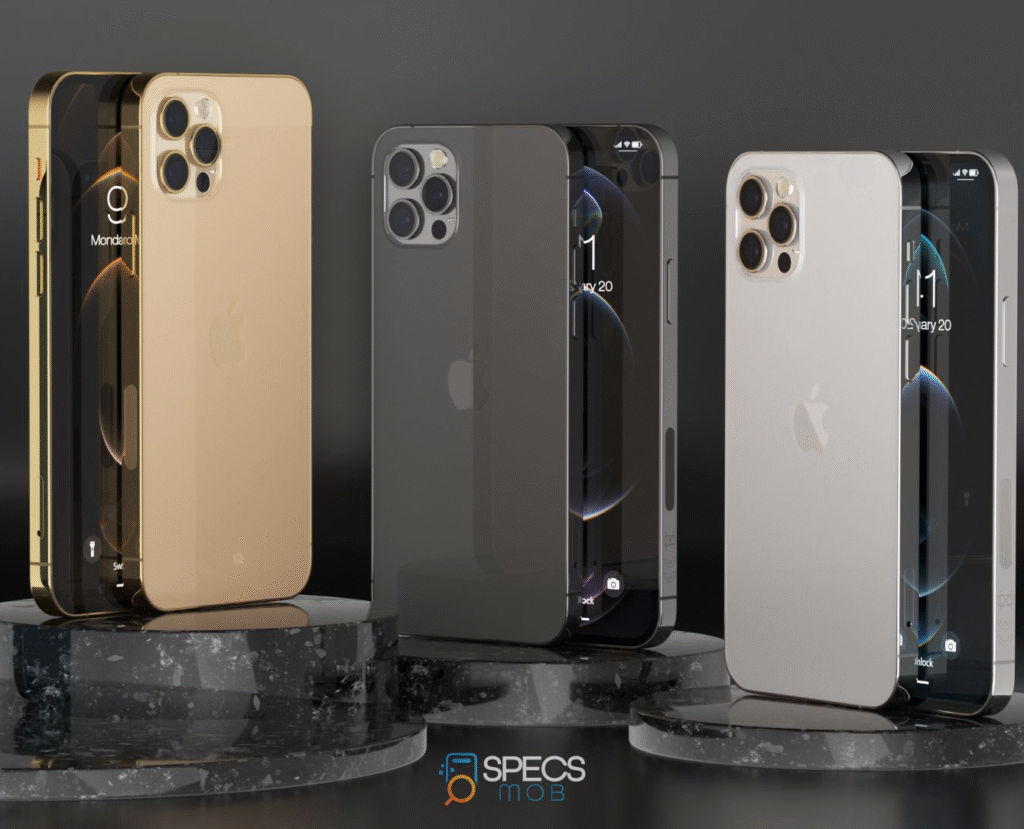
If you come from the Android camp, where even mid range smartphones will have high refresh rate displays by 2020, you’ll be a bit annoyed that the expensive iPhones don’t have them. We presume we’ll have to wait for the iPhone 13 Pro.
According to Apple, the iPhone 12 Pro display has an average brightness of 800 nits, while the iPhone 12 display has an average brightness of 600 nits. Both phones have a maximum brightness of 1,200 nits.
The iPhone 12 Pro’s maximum brightness was tested at 802 nits using our unique testing configuration, which is exactly what the display provides. The lowest brightness is surprisingly low, at 1.8 nits. With such a bright display, you wouldn’t even realize that no iPhone has the highest auto boost.
With a maximum variation of 3.0 and an average deltaE of 1.9, the iPhone 12 Pro’s screen has amazing color accuracy when compared to sRGB targets. When DCI-P3 material is shown, the iPhone 12 Pro automatically switches to this color space, which is fully supported by DCI-P3. The iPhone 12 Pro maintains its exceptional color accuracy, as it always has, even at its lowest brightness level of 1.8 nits.
Battery Life:
When compared to sRGB goals, the iPhone 12 Pro’s screen is very color accurate, with a maximum variance of 3.0 and an average deltaE of 1.9. When DCI-P3 material is shown, the iPhone 12 Pro automatically switches to this color space, which is fully supported by DCI-P3.
The iPhone 12 Pro maintains its exceptional color accuracy, as it always has, even at its lowest brightness level of 1.8 nits.
When we tried to drain the battery while playing games, the iPhone 12 Pro’s GPU turned out to be more efficient, giving us an extra hour of gameplay compared to the iPhone 11 Pro. The performance chapter will provide additional details on this.
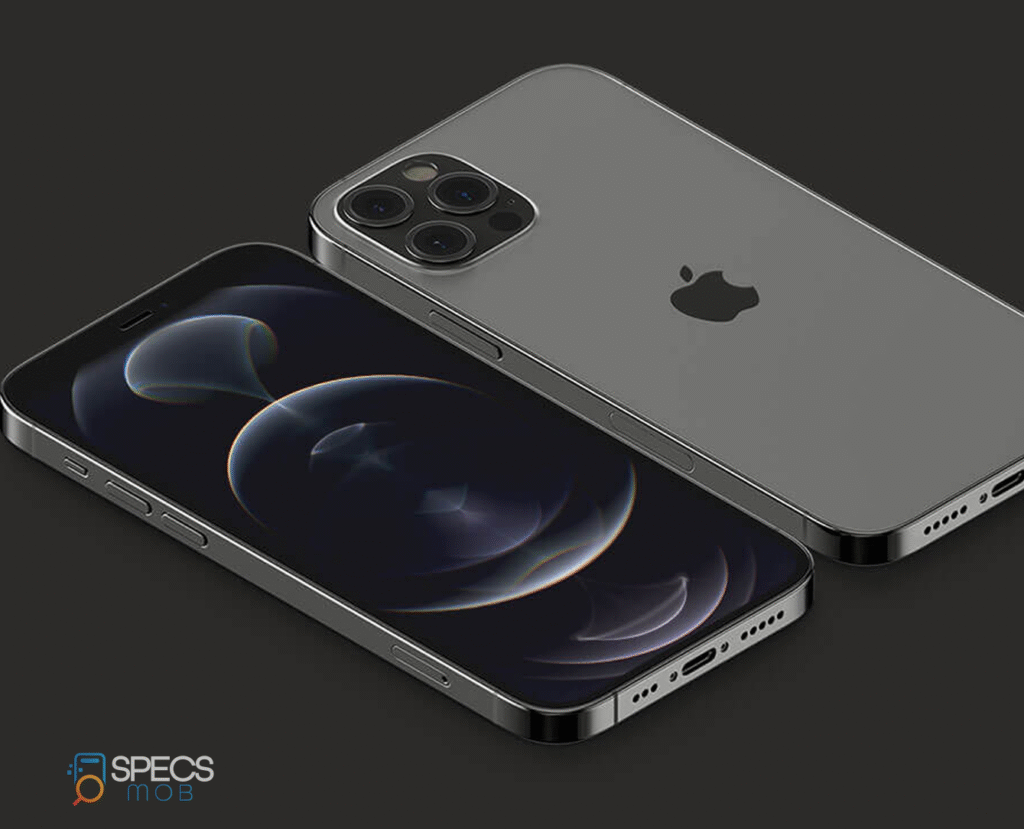
The Apple iPhone 12 Pro, like the iPhone 8, X, XS, and 11 series, features USB Power Delivery for rapid battery charging. As we have already stated, Apple sells this $1,000 phone without a charger. However, you may purchase a USB-PD compatible converter or the Apple 20W PD charger separately.
Performance:
The new LiDAR scanner was given a lot of hype by Apple for good reason. The miniaturization of LiDAR (Light Radar, Light Detection and Ranging, also known as Laser Imaging, Detection, and Ranging) technology is one of Apple’s most significant achievements. It first emerged on the iPad Pro before making its way onto the iPhone 12 Pro.
By measuring the reflections of the laser beams it emits, the LiDAR scanner calculates distances. As a result, the smartphone is able to produce a remarkably realistic three-dimensional picture of an item and place it practically anywhere. Are you thinking about buying new furniture? This will be perfect. Things that cannot be physically compared side by side can have their sizes compared using LiDAR.
The LiDAR scanner functions similarly to a high-end digital tapeline in that it can only be used for distance measurement due to its high degree of accuracy. You may also choose a distance and see simulated walls in real-time at that distance. The LiDAR scanner may be a helpful tool for interior designers and other experts.
You can enjoy a fantastic augmented reality experience with supported games and applications thanks to LiDAR’s strong augmented reality features, which are an added benefit.
Another advantage of this technology is that it allows for a quicker and more accurate focus in low light. Furthermore, the sensor is light-insensitive and capable of operating in a completely dark room, so you may now capture your first low-light images with great subject separation and blur.
To sum up, LiDAR-compatible apps, such as the 3D Scanner App, let you measure distances, scan and position objects anywhere, and export them for usage in your projects. Of course, there are many games where you can benefit from the improved augmented reality experience.
The iPhone 12 family is powered by Apple’s A14 Bionic CPU. It is the first 5nm chipset available for purchase, with a stunning 11.8 billion transistors, 40% more than the A13.
The A14 has a six-core CPU, much like the newest Apple CPUs. It features four smaller Icestorm cores operating at 1.8 GHz and two larger Firestorm cores operating at 3.1 GHz, with TurboBoost technology enabling the latter to run at 3.1 GHz as needed. The enhanced CPU should perform 50% better than the A13.
The new 4-core Apple GPU is expected to be up to 50% faster than the previous year’s iPhones. Next is the new 16-core NPU for machine learning, which increases AI performance by 70%. The iPhone 12’s non-Pro variants come with 4GB of RAM, while the Pro models come with 6GB.The entire iPhone 12 series supports 5G connection since it also includes Qualcomm’s X55 5G modem.
The upgraded camera quality is also mostly attributable to the new A14 Bionic chip and its ISP. The strength of the A14 enables additional capabilities like Dolby Vision recording, Night Mode, Deep Fusion, Smart HDR 3, and more.
The fact that the iPhone 12 and iPhone 12 Pro are the fastest iPhones ever should not be surprising. As usual, the Apple A14 has the most powerful CPU currently available. Although the Apple A14 Bionic chip may make the iPhone 12 Pro the fastest smartphone in the world, this is not one of the reasons to purchase a Series 12. Although they are three years old, iPhones have consistently performed well. The improved ISP and improved machine learning capabilities of the A14 processor are its most important features, as they advance computational photography to a higher standard.
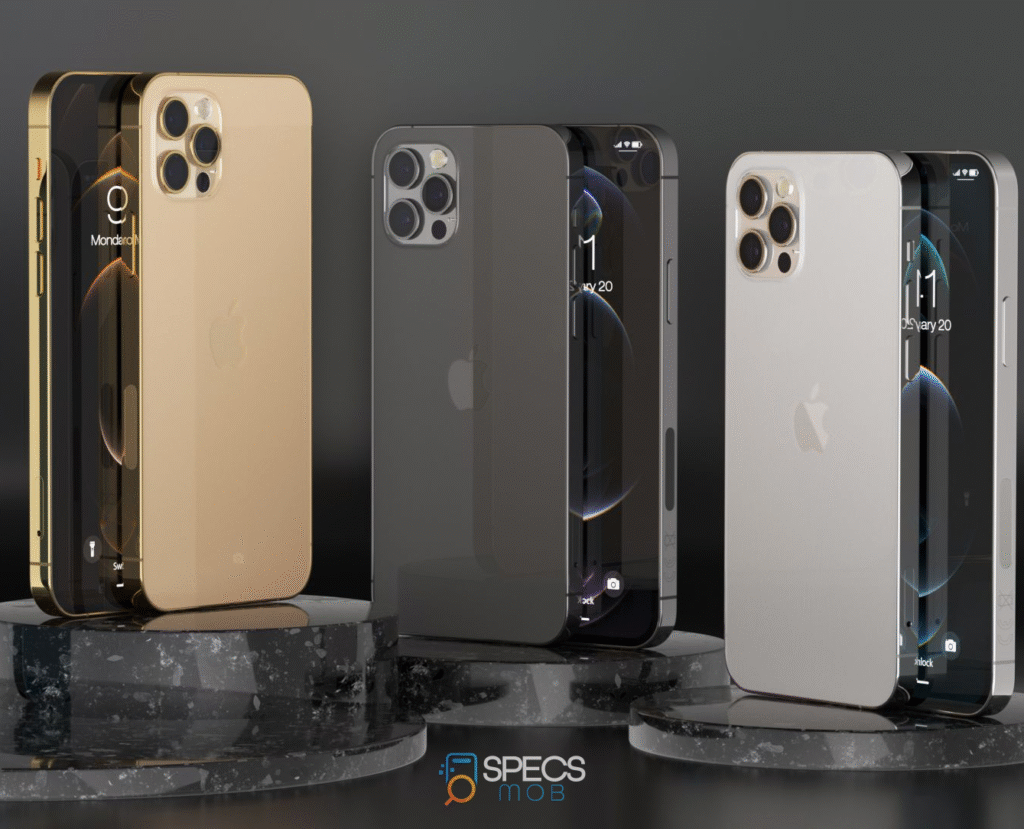
It shouldn’t come as a surprise that the iPhone 12 and iPhone 12 Pro are the quickest iPhones ever made. The A14 is still the most powerful CPU available, just like Apple’s earlier models. Although the Apple A14 Bionic chip might make the iPhone 12 Pro the fastest smartphone in the world, this won’t be one of the reasons to purchase a Series 12. iPhones have consistently performed well, even though they are three years old. What truly matters and advances computational photography to a new level are the A14 processor’s new features, such as the improved machine learning and the updated ISP.
Given the excellent frame rates obtained on the offscreen benchmarks, we may say with confidence that the 120Hz displays on the iPhones are already many years behind the times.
The iPhone is great for gaming, but the iPhone 12 Pro has a superior cooling system that lowers throttling during prolonged benchmarks or gaming sessions. The iPhone 12 gets quite warm around the frame and back glass, whereas the Pro version gets a bit warm. Additionally, it’s clear.
With a stability score of 90.9%, the iPhone 12 Pro passed the 3D Mark Wild Life Stress Test, which replicates 20 repetitions of the Wild Life graphic test.Initially, the iPhone 12 had an 84% stability rating. Nonetheless, it dropped to 75% after we loaded apps like Facebook, Skype, WhatsApp, Messenger, Bluetooth devices, and others. In contrast, the stability of an iPhone 11 Pro Max with a similar volume of traffic is 82%.
The results were, not unexpectedly, the consequence of a tough GPU test. We put Call of Duty Mobile through its paces on the iPhone 12 Pro and 11 Pro and found that both devices performed similarly, with no overheating or noticeable battery loss. The iPhone 12 Pro was able to play that game for 9 hours and 39 minutes, while the iPhone 11 Pro could only do so for 8 hours and 36 minutes.
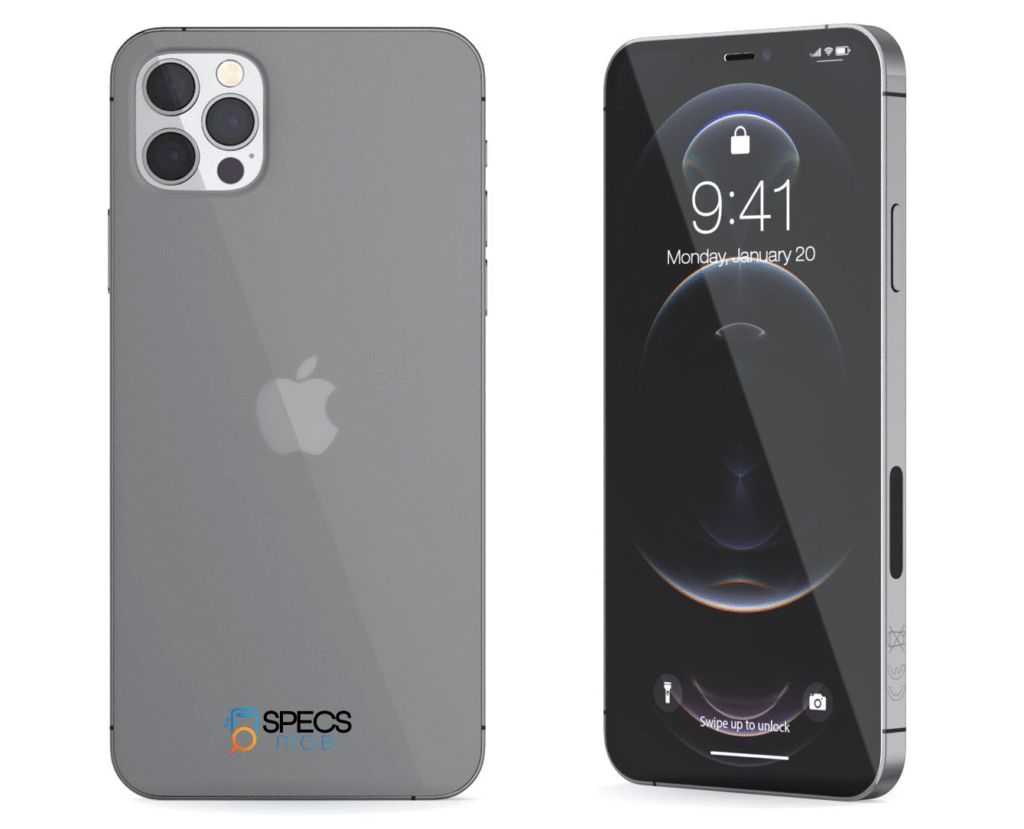
Gamers should choose the iPhone 12 Pro over the iPhone 12 because of its better cooling and stability. It also offers about an hour more playing time than the iPhone 11 Pro.
Summary :
The iPhone 12 Pro has a number of premium features over the iPhone 12, including a stainless steel frame, a triple camera configuration with a telephoto lens, and a LiDAR scanner. It boasts a 6.1″ Super Retina XDR OLED screen with Ceramic Shield for enhanced durability, even if it still doesn’t have a 120Hz refresh rate. The A14 Bionic chip improves low-light focus, photography, and augmented reality in addition to providing better performance. The Pro model has better heat management and a longer gameplay session than its forerunner. However, it includes nearly all of the same features as the iPhone 12, but it does not come with a charger or headphones. In spite of its strength and elegance, the glossy frame is slick and easily covered in fingerprints. Despite some real-world limitations, it is generally robust.
iPhone X Review 2025: Is This Anniversary OLED iPhone Still Worth It?
Apple Iphone X Review
Marking its anniversary is the iPhone X, often known as the iPhone 10. The phone’s name is equally confusing, although the innovation is revolutionary. Ultimately, Tim Cook’s vision prevailed over the final ideologies of Steve Jobs. With the elimination of the notorious screen bezels and the legendary Home key, a new era for iPhones has commenced.
The evolution of the smartphone industry has significantly benefited from the iPhone’s capacitive touchscreen, glass design, fingerprint scanner, Force Touch, and Portrait Mode over the past decade. Apple has continually advanced the frontiers by rendering undisclosed technological innovations available to millions of users. Moreover, they have accomplished this feat once again with the iPhone X features.
Face ID technology, previously regarded as a mere software trick, has now enhanced biometric security. Apple promptly eliminated Touch ID due to its strong confidence in its capabilities. Additionally, Face ID technology has facilitated a new dimension of selfies and remarkably accurate facial expression tracking through Animoji, a slight nudge that has the potential to propel the entire smartphone sector.
Not to mention the all-screen design, a bezel-free display. The mere elimination of the substantial bezels was adequate; however, Apple fully embraced the edge-to-edge iPhone X display. And yes, AMOLED display was fitting for a special edition smartphone like the X. The audio takes some time to adapt to. In terms of phone nomenclature, we have become accustomed to observing the letter rather than the numeral throughout the years.
The iPhone X encompasses the most advanced smartphone technologies provided by Apple and its suppliers: a state-of-the-art AMOLED HDR display, a newly designed stainless steel frame, dual optical stabilization in a redesigned camera, the highest-performing chipset available, an innovative depth-detection front camera, capability for wireless charging, and more, all of this at a marginally increased price.
Apple iPhone X Key characteristics
- Body: IP67 certified for protection against dust and water; stainless steel frame; reinforced glass front and back; colors: Silver, Space Gray
- Iphone X Display: 5.8″ bezel-less Super AMOLED display, 458 ppi, 1125×2436 resolution, wide color gamut (HDR video capable), True Tone, 3D Touch, six-channel ambient light sensor
- OS: iOS 11
- Chipset: Hexa-core (2 Monsoon + 4 Mistral); Apple A11 Bionic, tri-core GPU, 2.39 GHz CPU
- Memory & Storage: 64/256 GB non-expandable; 3 GB RAM
- Rear Camera: Dual 12 MP (wide f/1.8 + telephoto f/2.4), both with OIS; two lossless zooms; quad-LED flash; phase-detection autofocus; wide color capture
- Video Recording: 1080p (30/60/120/240 fps), 4K (30/60 fps)
- Selfie: 7 MP f/2.2 TrueDepth front camera, Animoji, depth detection for Portrait Mode, 1080p@30fps
- Connectivity: GPS (A-GPS, GLONASS, GALILEO, QZSS); Bluetooth 5.0; Wi‑Fi a/b/g/n/ac; LTE Cat.12 (600 Mbps); NFC for Apple Pay and NFC tag reading
- Battery: 2,716 mAh, Qi wireless charging enabled; includes fast-charge via USB-C to Lightning
- Extras: Taptic Engine, dual stereo speakers, TrueDepth camera system
IPhone X Specifications Table
| Feature | Specification |
|---|---|
| Body & Build | IP67 water/dust resistance, stainless steel frame, reinforced glass (front & back) |
| Display | 5.8″ Super Retina AMOLED, 1125×2436 pixels, 458 ppi, HDR, True Tone, 3D Touch |
| Operating System | iOS 11 |
| Processor (Chipset) | Apple A11 Bionic (2x Monsoon + 4x Mistral), 2.39GHz, tri-core Apple GPU |
| RAM & Storage | 3GB RAM, 64GB or 256GB internal storage (non-expandable) |
| Rear Camera | Dual 12MP (f/1.8 wide + f/2.4 telephoto), OIS, dual zoom, quad-LED flash |
| Front Camera | 7MP f/2.2, TrueDepth sensor, Animoji, Portrait mode, 1080p video |
| Video Recording | 1080p at 30/60/120/240fps, 4K at 30/60fps |
| Battery | 2,716mAh, Qi wireless charging, fast charging capable (USB-C to Lightning) |
| Connectivity | LTE Cat 12, Bluetooth 5.0, Wi-Fi a/b/g/n/ac, GPS, NFC (Apple Pay, NDEF) |
| Miscellaneous | Taptic Engine, dual stereo speakers, Face ID technology, TrueDepth front camera |

Apple iPhone X Significant Limitations
The notch design impacts UI layout and sometimes appears obtrusive
Touch ID fingerprint sensor is gone
Although there isn’t a 3.5mm audio connector, a Lightning-to-3.5mm adapter is included.
The package lacks a microSD slot and a rapid charger.
The Iphone display space may not be used to its full potential by iOS motions, which need a significant learning curve.
Video camera records mono sound
Apple iPhone X Design & Display Insights
There is iphone notch controversy, but it’s a fair compromise for the captivating edge-to-edge display. The vertical camera hump is still apparent, notwithstanding the premium aspect of the glass back. Though the stainless-steel frame increases longevity, it is also heavier and more easily scratched. Apple strengthened the glass surfaces with a rubber gasket to increase impact resistance and water resistance. Despite its thinner form than the 8 Plus, the notch and software modifications confine the iPhone X’s effective screen area. Yet, it demonstrates Apple’s talent for creating high-quality products.
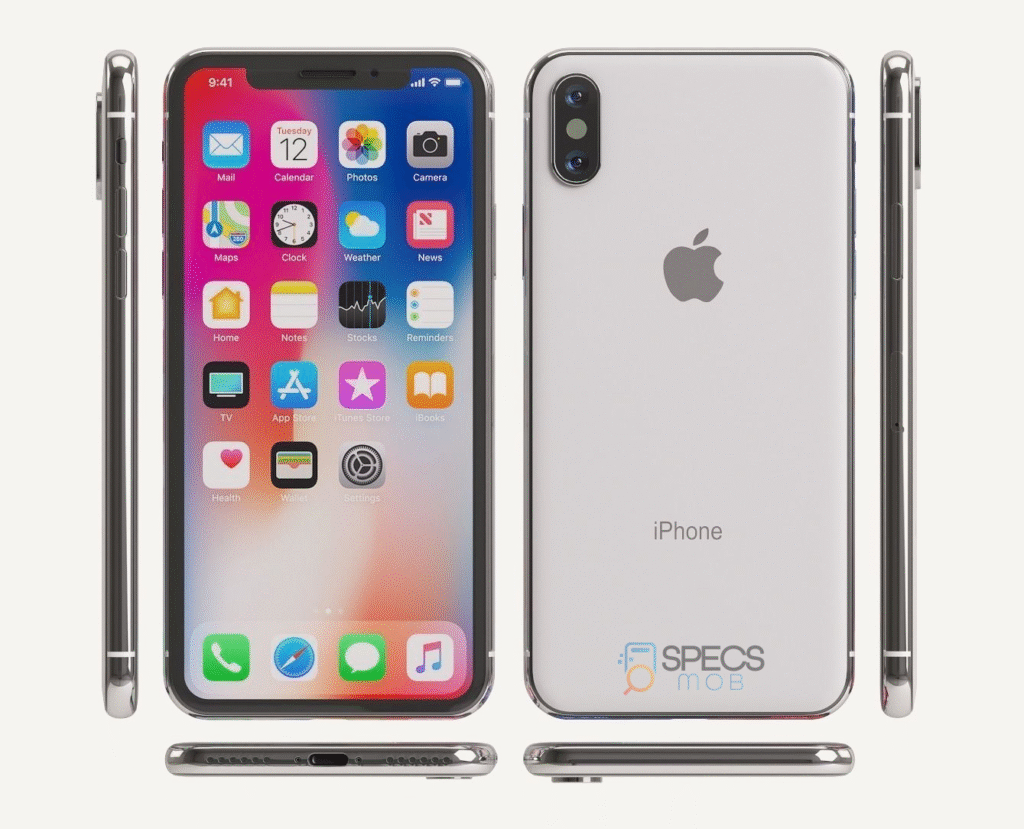
Apple iPhone X Performance
The 5.8″ AMOLED HDR screen (19.5:9, 458 ppi) offers True Tone support and average brightness of 679 nits—brighter than Apple’s claimed 625 nits. Excellent contrast and outdoor visibility match or outdo many Samsung AMOLED displays. With a DeltaE of 1. 9, color accuracy is still excellent. Though the trade-off is justified given the display’s outstanding quality—including HDR support, great contrast, and a broad color range—the notch and rounded edges really limit the amount of usable space.
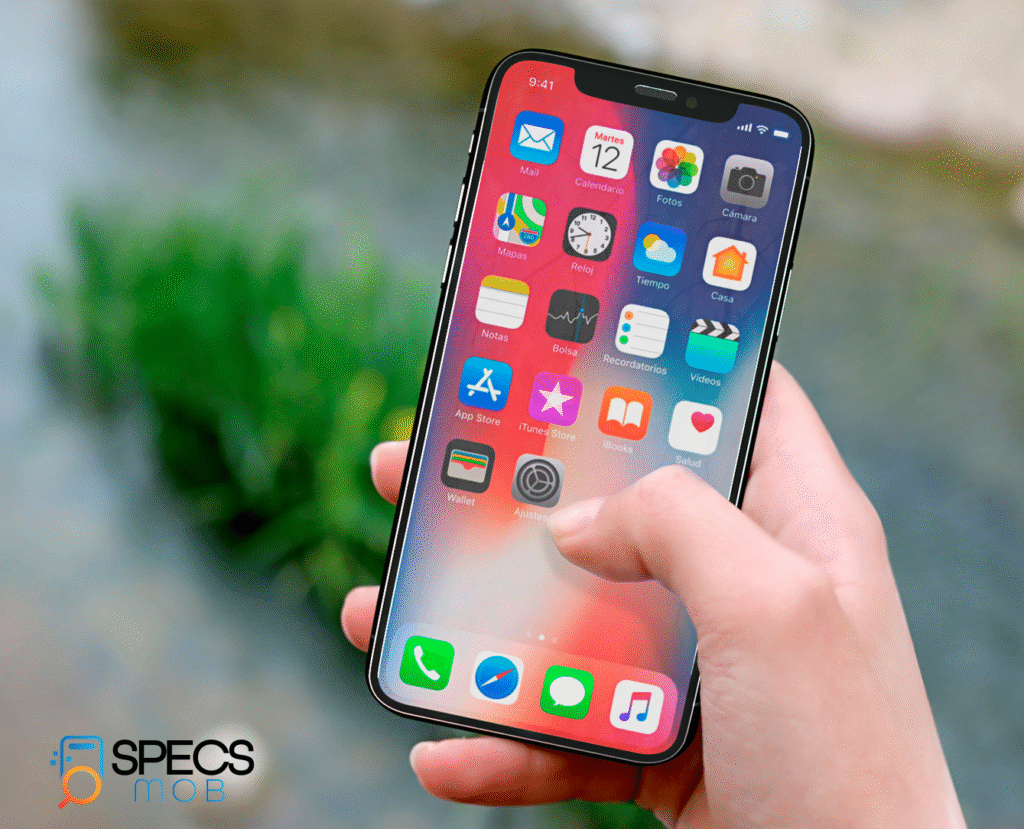
IPhone X Battery Efficiency
The iPhone X has a 2,716-mAh battery. With a 5V/1A charger, it charges to 20% in 30 minutes; wireless charging charges it to 17% in the same time. Using a high-wattage converter and a USB-C to Lightning cable, it can charge up to 45% in 30 minutes.
Tested battery life:
- 12 hr video playback
- 9.5 hr web browsing
- 19 hr 3G calls
- Combined endurance: 74 hours
Despite the OLED’s higher power draw, efficient hardware and software design help reach that 74-hour benchmark.
IPhone X Connectivity & Features
The iPhone X supports LTE Cat. 12, Bluetooth 5.0, Wi‑Fi a/b/g/n/ac, VoLTE, HD Voice, Wi‑Fi Calling (carrier-dependent), GPS, and NFC (for Apple Pay). The Lightning port handles charging, audio, and data, but lacks full USB host mode. Bluetooth keyboards are supported. Though adapters and carrier settings are required, the device offers well-rounded connectivity.
Performance Powerhouse of the Apple iPhone X
Apple’s A11 Bionic chip (10 nm) includes two Monsoon performance cores and four Mistral efficiency cores. It also added a dual-core Neural Engine for AI tasks and a new tri-core GPU—30% faster than its A10 predecessor.
Performance leaps:
In everyday use, the iPhone X delivers seamless multitasking, smooth gaming, and efficient power handling
CPU: +25% vs A10
GPU: +30% vs A10
Benchmarks show it outpaces Qualcomm’s Adreno 540 and previous iPhones on single-core tests
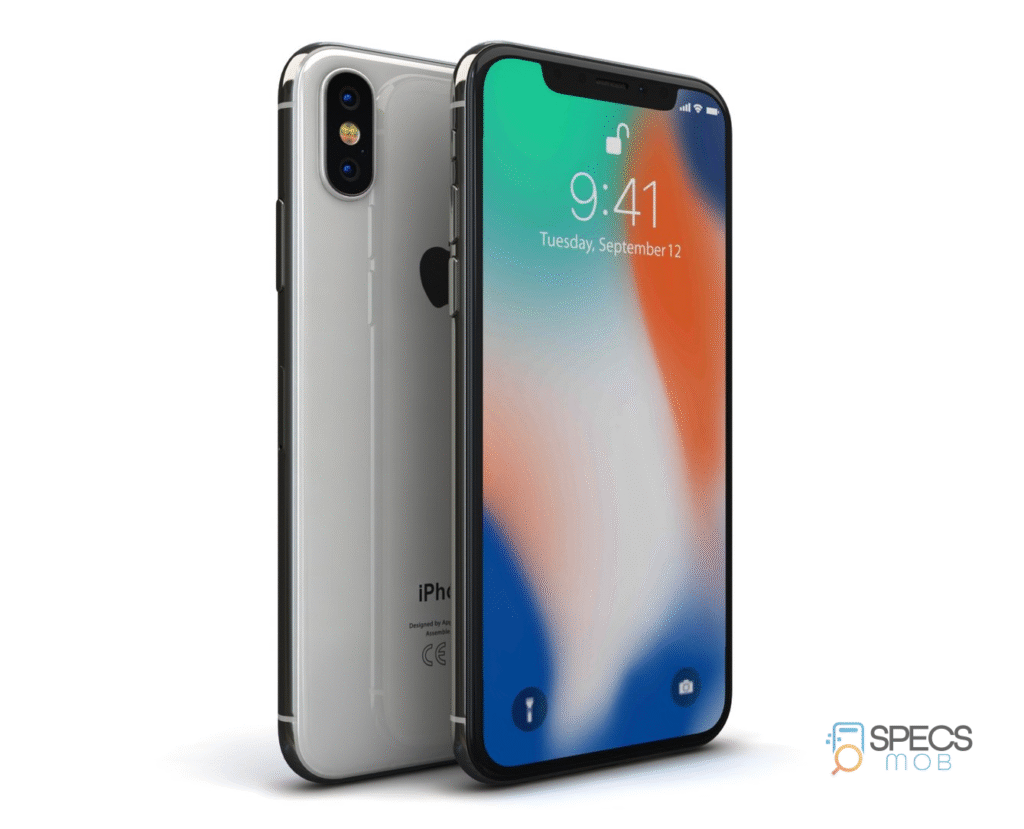
IPhone X Summary
Along with its sturdy stainless-steel body and edge-to-edge AMOLED screen, the iPhone X offered Face ID technology, a daring new appearance. Driven by the fast and potent A11 Bionic CPU, its dual-lens design with dual-optical image stabilization let it claim best-in-class camera capabilities and performance. With wireless and quick charging capabilities, Apple also embraced the future. Though it sparked debate regarding the removal of the Home button, Touch ID, and the conventional 3.5mm headphone connection, the iPhone X raised the bar for smartphones. With its excellent HDR photographs, smooth performance, and remarkable battery life, it marked the iPhone’s entry into a new age. This iPhone X review explores how Apple’s bold redesign—featuring Face ID technology, a vibrant OLED display, and top-tier performance—set a new benchmark for modern smartphones.
Apple IPhone XR Review
October 26, 2018 iPhone XR was released. Although the two versions of the iPhone XS are almost identical except for their sizes, the iPhone XR marks a major shift from the iPhone X series, indicating the start of a new era.
When Phil Schiller presented the iPhone XR, he stated that Apple intended to make the technology and experience of the iPhone XS available to a broader audience, and the iPhone XR serves as their solution to accomplish that. It aims to deliver the same design, features, and user experience as the iPhone XS while being less expensive.
To begin, the iPhone XR is offered at a price of $749, which is $250 lower than the regular iPhone XS. So, what trade-offs are accepted for this lower price? The LCD features a reduced resolution, the device is larger and heavier, and it is constructed from aluminum. Furthermore, there is just one rear camera.
The general layout of the iPhone X series remains unchanged, as does the powerful A12 Bionic processor from the XS, the TrueDepth camera with its quicker Face ID technology, and the single rear camera, which is the same main 12MP sensor as that found in the XS.
Adding to the excitement, the iPhone XR is available in six unique colors, the most options Apple has ever offered for any iPhone.
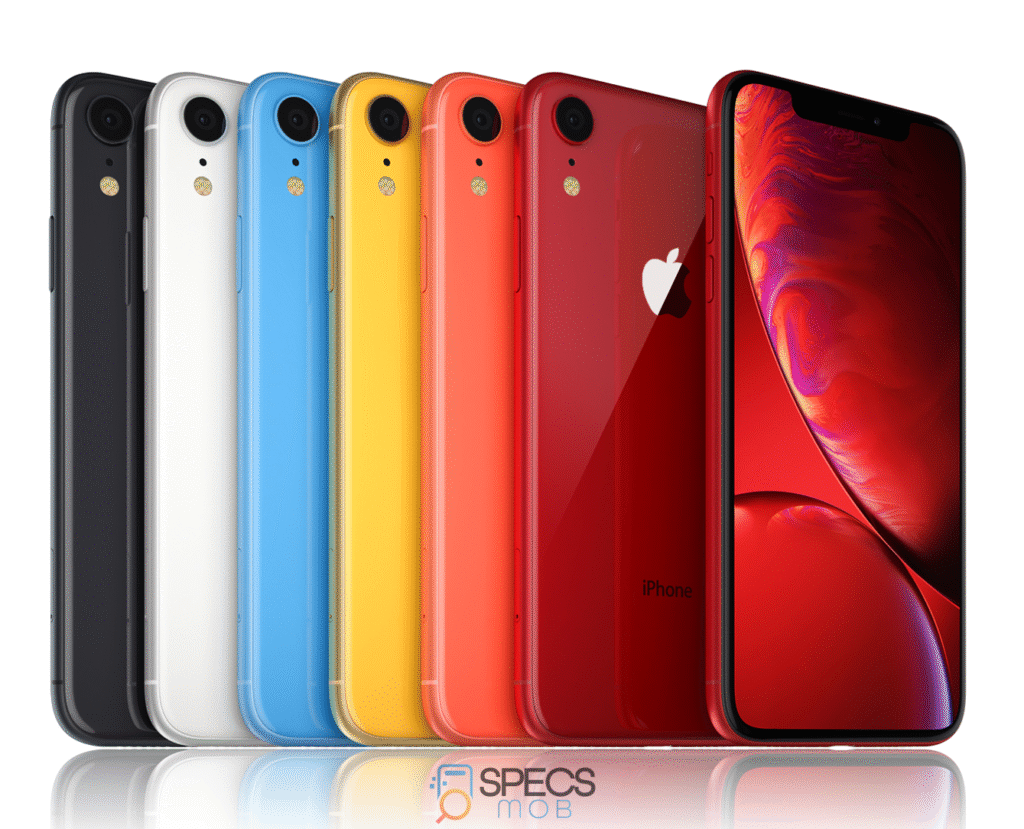
Body: aluminum frame, glass back, IP67-rated, six colors.
Display: 6. 1-inch, 1792 x 828 (326 PPI), IPS LCD, 1400:1, wide-color (P3)
12MP rear camera with f/1.8, OIS+EIS, dual pixel PDAF, quad-LED flash, 4K60 video, and wide-color capture.
Front camera: 7 MP, f2. 2, 1080p60, EIS, display flash, and wide-color
Software: iOS 12.
Chipset: Apple 12 Bionic, 2. 49GHz six-core CPU (2x Vortex + 4x Tempest), quad-core Apple GPU, and octa-core Neural Engine.
Memory: 3GB LPDDR4X SDRAM and 64/128/256GB NVMe storage.
Connectivity: Dual SIM (nano SIM + eSIM), LTE-A, Dual-band Wi-Fi 802. 11ac with 2×2 MIMO, Bluetooth 5. 0, AGPS/GLONASS/Galileo/QZSS, NFC (only for Apple Pay).
Battery: 2942mAh, USB-PD rapid charge support, Qi charging support, and 5W included charger
Miscellaneous: TrueDepth camera system with Face ID and stereo speakers.
Finding the perfect balance between pricing, features, and performance is quite difficult. It remains to be seen if Apple has succeeded, but we can only know for sure after using the smartphone for a while. Apple allowed us to have the smartphone before its official launch, and after a full week of use, we believe we have our conclusion.
One observation is certain: this is undoubtedly the most exciting iPhone released this year. The iPhone XR and iPhone XS are the same in terms of packaging. The same accessories are included with both devices, comprising the Lightning to USB cord, the EarPods with Lightning Connector, and a modest 5W charger. Although the design is quite minimalist and helps to reduce waste, we hope Apple had at least provided a higher wattage charger, such as the 12W unit that is supplied with the iPads or the 10W model that was previously offered with certain iPhones.
Design
The iPhone XR underscores its place within the iPhone X-series by adopting a similar foundational design to that of the iPhone XS. Its color options include black, white, blue, yellow, coral, and Product RED. The frames of the blue, yellow, and coral variants are misaligned, resulting in a somewhat disorganized look, in contrast to the coordinated frames of the black and white variants. Nevertheless, the Product RED model showcases Apple’s charitable contributions while also presenting a cohesive aesthetic with its brilliant red back and corresponding frame.
Although it retains a high-end design, the iPhone XR appears somewhat bulkier than the iPhone XS due to its larger, thicker, and heavier dimensions. Its aluminum frame is more resistant to scratches and offers greater durability than the stainless steel of the XS, albeit with a less refined finish. Both the front and rear are made of glass; according to Apple, the front glass is the most durable found in a smartphone, while the rear glass proves to be more resilient than that of the iPhone X but less robust than that of the XS.
In comparison to the OLED panel of the iPhone XS, the LCD display of the XR features larger bezels. Although the bezels remain noticeable, especially on the black model, Apple has made advancements in LCD technology that position the display closer to the edges than previous iterations.
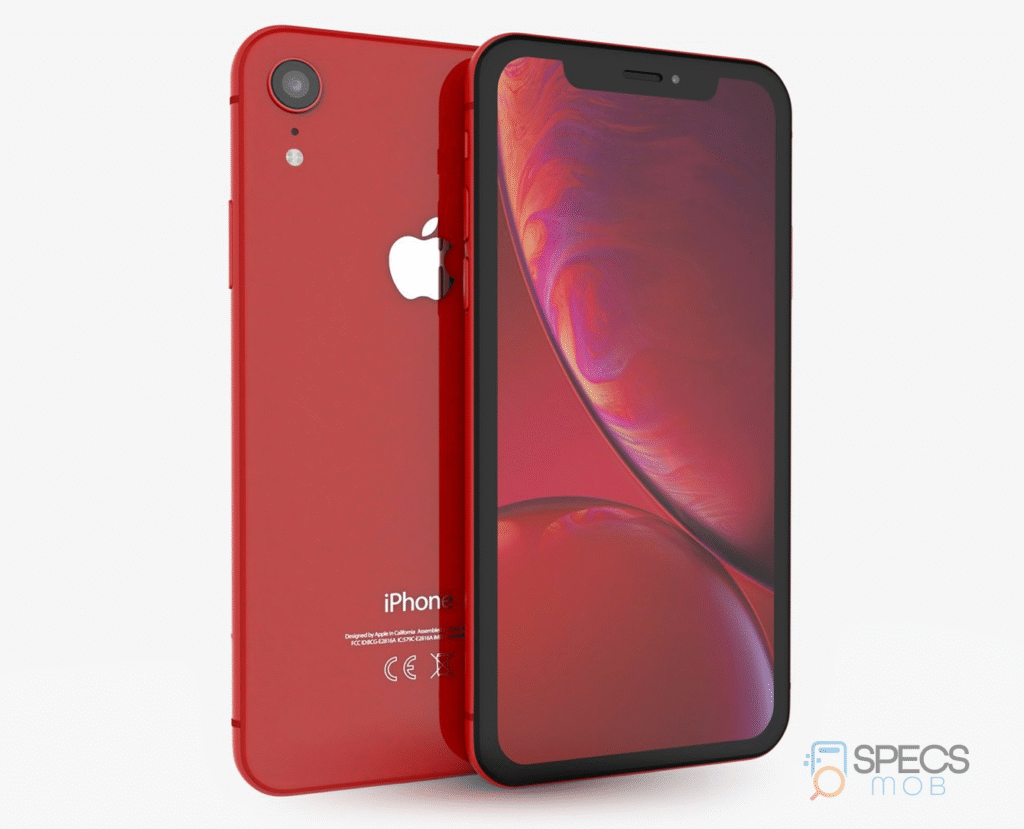
Taking into account the limitations of LCD technology, the uniform bezel that encircles the display is commendable, even though it lacks the sleekness of the XS.
The iPhone XR features a polished back devoid of any regulatory markings, a quad-LED True Tone flash, and a single rear camera that extends noticeably. Although the Lightning port is slightly misaligned with the speaker and microphone grille, the buttons remain positioned identically to those on the XS. The device can be submerged at a depth of one meter for up to thirty minutes, as it possesses an IP67 water resistance rating.
In summary, the iPhone XR presents a flagship-level design available in a variety of hues. While it may not exhibit the same refinement as the XS, it nonetheless qualifies as a high-end, durable, and visually appealing device.
Display
The 6. 1-inch IPS LCD featured on the iPhone XR possesses a resolution of 1792×828 (326PPI), which is comparable to that of smaller iPhones; however, it is not as sharp as the OLED and Plus models. It accommodates DCI-P3 broad color and True Tone, achieves a brightness level of 700 nits, and exhibits commendable color accuracy (DeltaE 0. 6). Nonetheless, it depends on software to emulate HDR and lacks hardware support for 3D Touch and HDR. When compared to OLED, the LCD has more prominent bezels and reduced contrast, yet it provides exceptional viewing angles and brightness. The 120Hz touch layer ensures smooth responsiveness, while suitable touch rejection enhances usability. Although upgraders from Plus models may find the pixel density disappointing, the display remains bright and clear, thus serving as a robust performer despite its LCD limitations.
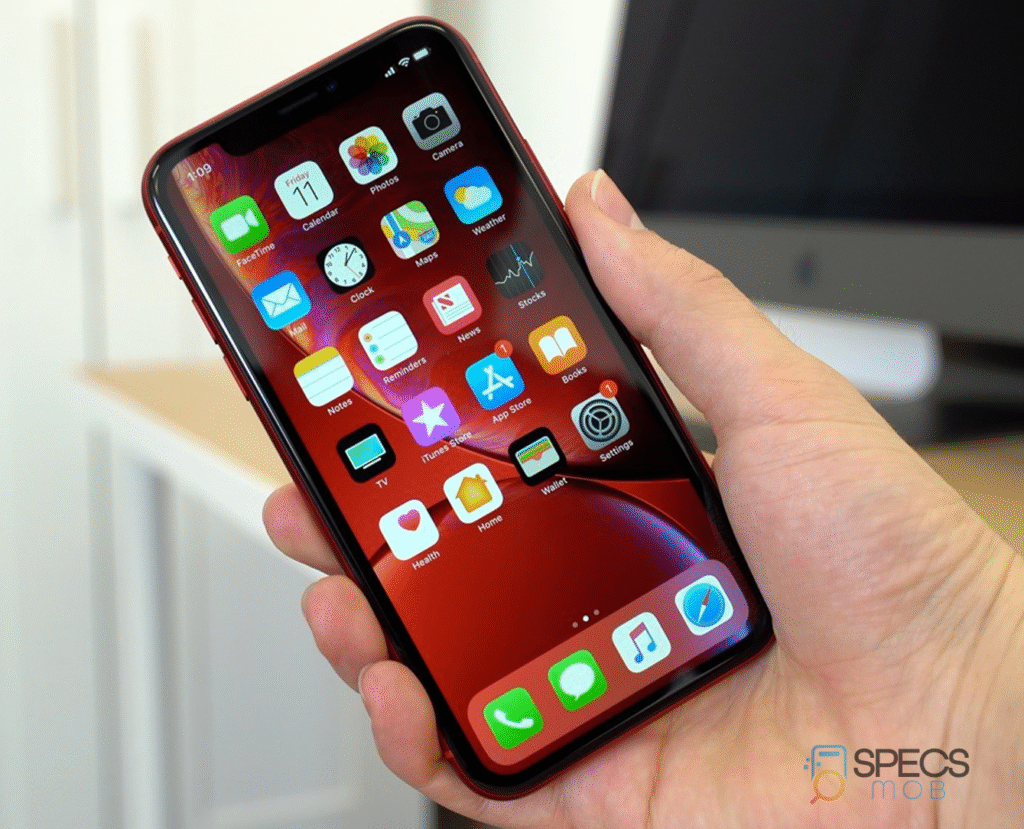
Battery Health
With a 2942mAh battery, the iPhone XR possesses the longest battery life of any of Apple’s 2018 iPhone models. It offers 20–22 hours of use and 6–7 hours of screen time, effortlessly supporting a full day with 15% remaining. It attained a 78-hour endurance rating following tests that involved 13 hours of online surfing, over 15 hours of movie playback, and 15 hours of 3G conversations. However, it requires three hours for the included 5W charger to achieve a full charge. A 12W iPad charger represents a more economical alternative, but Apple recommends a 30W USB-C converter and connection for expedited charging. Although wireless charging is also available, it performs optimally overnight. The charging process continues to be a drawback despite the battery’s commendable performance.
Performance
Apple’s 7nm A12 Bionic chipset drives the iPhone XR. It features a quad-core GPU, an octa-core Neural Engine, and a six-core CPU (comprising two robust Vortex cores and four efficient Tempest cores). In contrast to the A11, the A12 delivers 15% superior CPU performance, 50% enhanced graphics, and improved battery efficiency. It represents the fastest smartphone processor available on the market, surpassing competitors such as the Kirin 980. The iPhone XR exhibits superior performance in graphics assessments due to its lower resolution display. The upgraded Secure Enclave within the A12 facilitates quicker and more reliable Face ID functionality. While RAM may potentially become a limiting factor in the future, the iPhone XR’s 3GB RAM guarantees that it will remain future-proof for several years, demonstrating impeccable real-world performance.
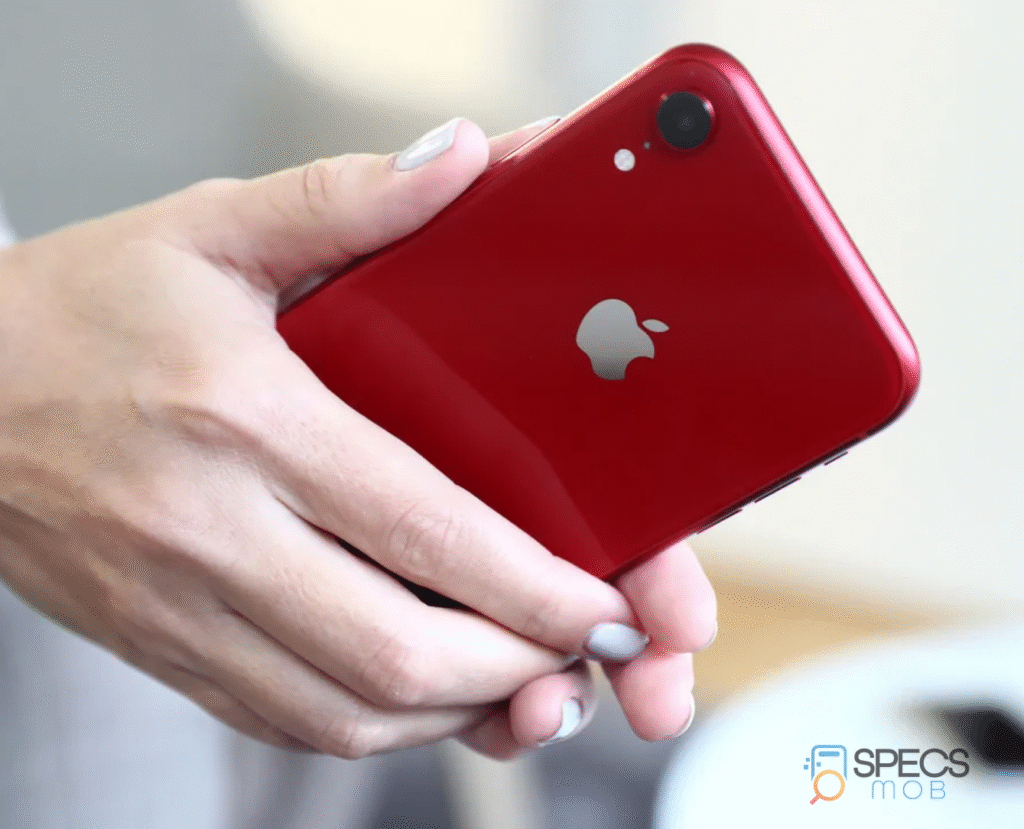
Summary
The iPhone XR was launched after the iPhone XS and XS Max to offer similar functionality at a lower price of $749—$250 less than the XS. It features a 6.1-inch LCD display, a single rear camera, and the powerful A12 Bionic chip. Available in six colors, the XR has an aluminum frame, glass back, and an IP67 water and dust resistance rating. With 3GB of RAM and storage options of 64GB, 128GB, and 256GB, it also offers impressive battery life. Overall, the iPhone XR balances cost, features, and performance, making it one of the year’s most exciting launches despite some compromises.
Apple IPhone 11 Review
Introduction
The initial commercial success of the second effort to develop a more affordable iPhone was the iPhone XR. We thought that the producer would not pursue this idea again following the lackluster reception of the iPhone 5c in 2013. Given that the iPhone XR was the top-selling version of the three last year, we are happy to present the iPhone 11 this year.
The iPhone XR, which featured an LCD display, a single rear camera, and an impressively long battery life, was essentially a more affordable and less flashy alternative to the XS series. However, within Apple’s realm, the words “affordable” and “less expensive” carry distinct interpretations.
In reality, the iPhone 11 is now more affordable this year than the XR was at its launch; it is priced at $700 compared to $750. The positive aspect is that the base model iPhone includes several appealing enhancements and nothing has been omitted.
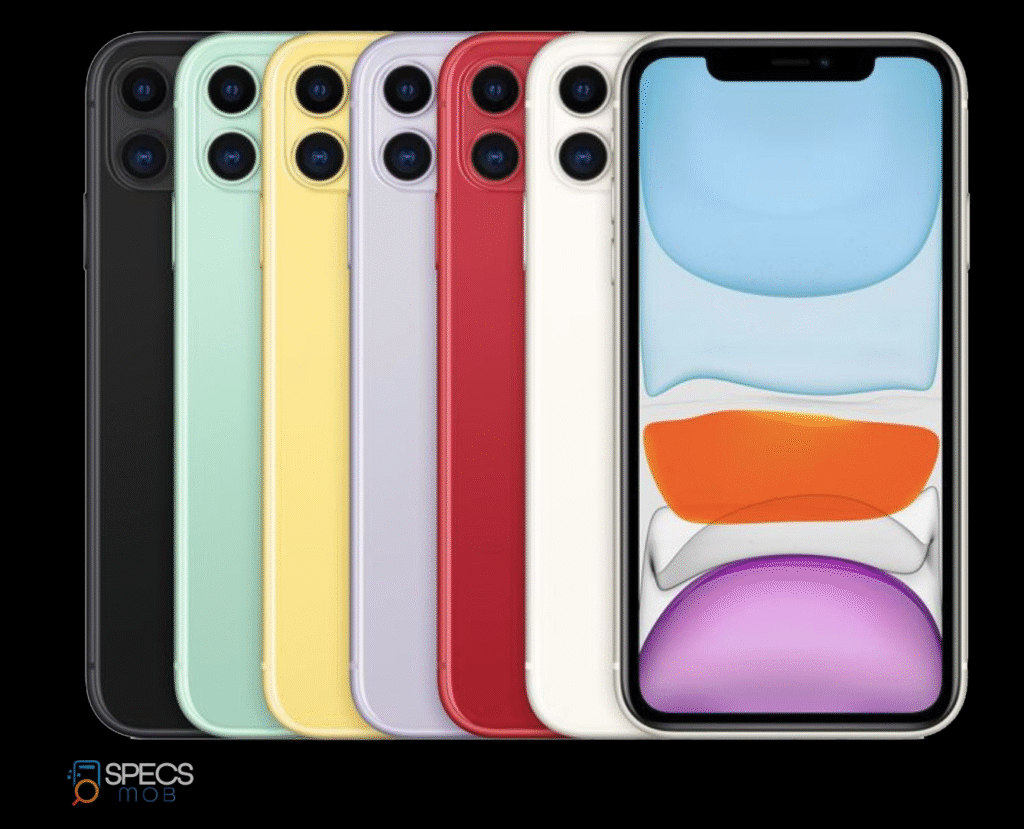
Consequently, the form factor and display of the iPhone 11 are identical to those of the XR. It utilizes the same 6. 1″ IPS LCD display with 326 ppi and features a Face ID technology notch at the top. The display’s brightness, contrast, haptic touch, and other characteristics remain unchanged.
The new Apple A13 Bionic technology, which powers the flagship iPhone 11 Pro models, is incorporated in the iPhone 11. Moreover, it includes a secondary camera, the new 12MP super wide-angle camera that was also part of the Pro models. Furthermore, you have the ability to capture 4K video with all of your cameras simultaneously and employ capabilities such as Crop Out of Frame.
The iPhone 11 now features the updated 12MP selfie camera. This 12MP camera comes with a 23mm wide lens and offers the capability to record 4K at 60 frames per second or 4K at 30 frames per second with an enhanced dynamic range. The front-facing camera includes cinematic stabilization across all modes.
The iPhone 11 is now equipped with a 3,110mAh battery rather than the 2,942mAh battery found in the XR, a result of Apple’s skill in accommodating a larger battery within the same chassis as the previous year.
Although the iPhone 11 supports 18W charging, it lacks a fast charger, unlike the Pro models.
The iPhone 11 is distinct from the XR because it features a new camera and chip, along with numerous new and exciting software functionalities. Furthermore, Apple is now offering the 11 in various colors, including purple and green (we have the green model here for review).
Specifications of the Apple iPhone 11
- Body: IP68 rated for water and dust resistance, aluminum chassis, oleophobic-coated Gorilla Glass front, glossy Gorilla Glass back. Color options consist of black, green, yellow, purple, white, and red.
- Screen: 6. 1″ IPS LCD display with broad color range, touch sensitivity at 120 Hz, 326 ppi, 625 nits brightness, and 828 x 1792 px resolution. A six-channel ambient light sensor is implemented to adjust the tone.
- Operating system: iOS 13
- Chipset: Hexa-core (2×2. 66 GHz Lightning + 4×1. 8 GHz Thunder) Apple A13 Bionic chip (7nm+) Three-generation Apple CPU, four-core Apple GPU, and eight-core Apple NPU
- Memory: 64/128/256GB of internal storage; 4GB of RAM
- Dual 12MP camera: 13mm ultra wide-angle, F/2. 4, 120-degree field of view; quad-LED flash with slow sync; 26mm main wide-angle, F/1. 8, OIS, Dual Pixel AF
- Video recording: OIS + EIS, 1080p@30/60/120/240 fps, 2160p@60/30 fps, featuring enhanced dynamic range and spatial audio.
- This selfie comprises two cameras: a 23mm 12MP F/2. 2 front-facing camera equipped with HDR mode and a 3D TOF camera; it captures videos at 2160p@60/30 fps and 1080p@60/120 fps with improved dynamic range, spatial audio, EIS, and depth detection for portrait mode.
- Wi-Fi a/b/g/n/ac/ax; Bluetooth 5. 0; dual SIM, 4G LTE (1 Gbps); GPS with A-GPS, GLONASS, GALILEO, and QZSS; NFC; Apple U1 chip ultrawideband.
- Battery: Qi wireless charging, 18W fast charging, 3,110 mAh.
- Miscellaneous: Taptic Engine, dual speakers, and a specialized TrueDepth camera for Face ID.
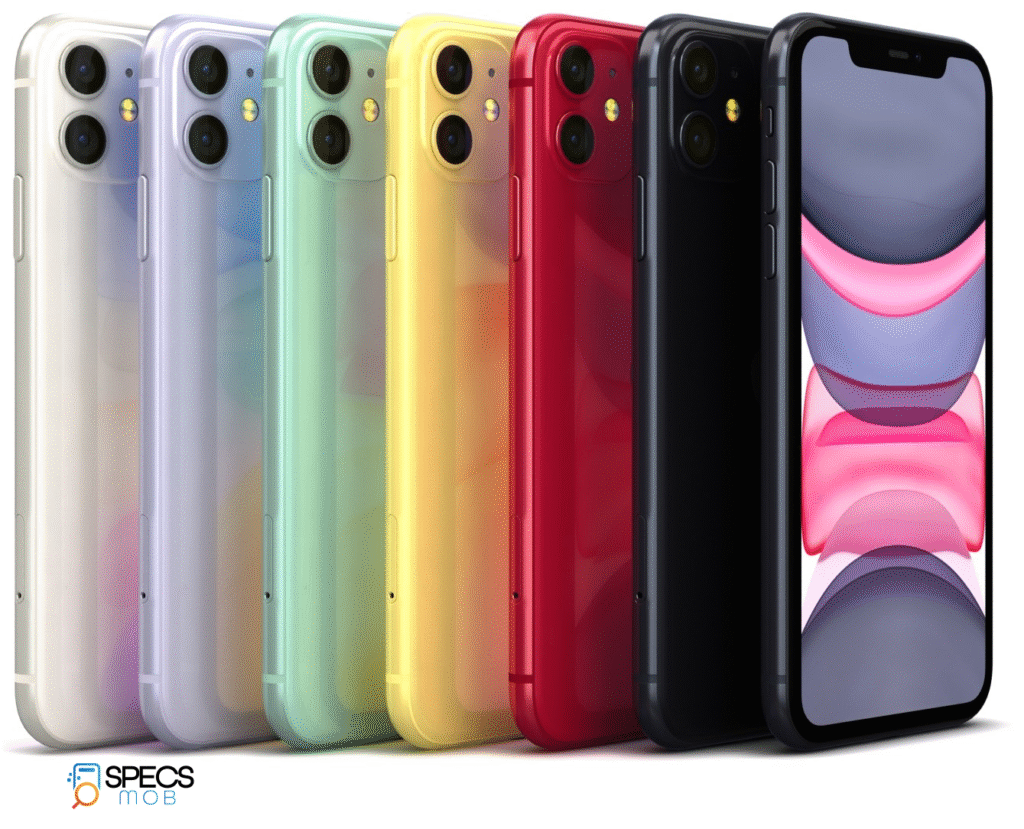
Enhanced water protection is yet another characteristic of the iPhone 11, which might have sturdier glass on both the front and back. The latter, we conjecture, will ultimately be verified through time and instances of dropping.
In any case, let’s commence this assessment now that we are ready to unbox the iPhone 11.
The white packaging of the iPhone 11 is somewhat larger than the device itself. The iPhone 11 is accompanied by a regular Lightning cable, a set of EarPods that connect to a Lightning port, and the outdated 5W charger.
Apple no longer includes a 3. 5mm adapter with the iPhones.
The new 18W Apple charger included with the Pro models is not included with the iPhone 11, despite its compatibility with 18W fast charging through USB Power Delivery. Nevertheless, since the iPhone 11 is $50 cheaper than the XR, you might be able to use the saved amount to buy the 3. 5mm converter ($9), the required USB-C-to-Lightning 1m cable ($19), and the previously mentioned 18W charger ($29).
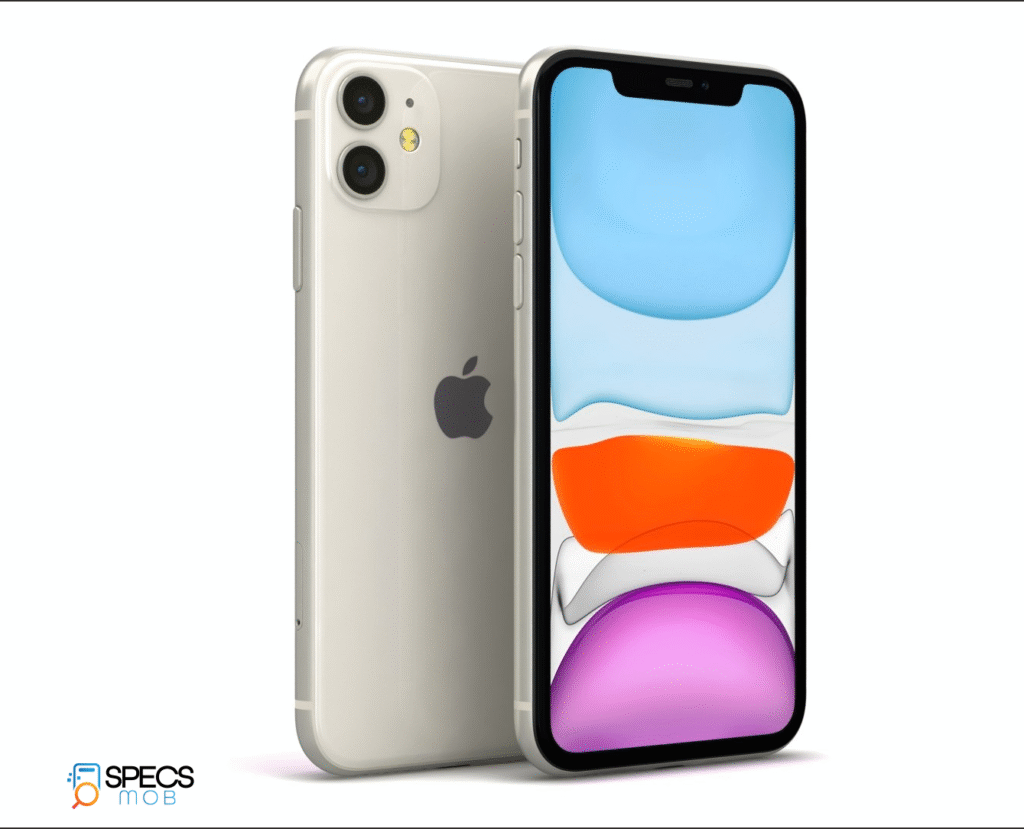
Design
With a 6. 1-inch LCD display, a prominent Face ID notch, and considerable bezels reminiscent of the iPhone XR, the iPhone 11 upholds the classic iPhone aesthetic. It features a flat glass front with 2. 5D edges and Corning’s patented “toughest glass” protection. The brushed metal frame gives it a lightweight and smudge-resistant build. On the rear, a matte-textured square camera module houses two 12MP cameras—a primary wide lens equipped with OIS and an ultrawide camera that lacks a zoom lens—along with a glossy glass design that has the Apple logo placed centrally on the back. The device comes in new colors, including a vivid purple, and the camera bump is less pronounced than expected.
With a broader angle lens for improved Face ID functionality and digital stabilization, the front 12MP selfie camera is now capable of recording 4K video at 60 frames per second. Haptic Touch, which depends on prolonged presses accompanied by taptic feedback, substitutes 3D Touch in the iPhone 11. Its weight (194g) and dimensions (150. 9 x 75. 7 x 8. 3 mm) are the same as those of the XR, but it has been enhanced to IP68 water resistance, allowing for submersion in 2 meters of water for 30 minutes.
Similar to the XR’s, the display does not have the contrast and brightness of OLED but is still durable and cleanable thanks to its oleophobic coating. Stereo speakers, a quiet mode, and a Lightning port are included among the phone’s standard features. The mid-sized form factor makes it easy to use with one hand, and the brushed frame improves grip even though it is somewhat slippery.
Taking everything into account, the iPhone 11 delivers a familiar iPhone experience along with slight upgrades such as improved cameras, higher water resistance, and a solid design, making it a viable option for those seeking something more affordable than the Pro models.
Display
Similar to the XR, the iPhone 11 features a 6. 1-inch Liquid Retina IPS LCD display with a large notch, 326 pixels per inch, and a resolution of 828 x 1792. While its LCD panel limits it from supporting HDR10 or Dolby Vision, it boasts a wide color gamut thanks to DCI-P3 and excellent color accuracy (average DeltaE 1. 1). The display can reach a maximum brightness of 644 nits with a contrast ratio of 1500:1, and True Tone adjusts the white balance based on the ambient light. Although the refresh rate remains at 60 Hz, the touch input has a polling rate of 120 Hz to minimize latency. Even in low light conditions, the display delivers sharp images, precise colors, and consistent performance, even though it has a lower resolution than OLED devices.
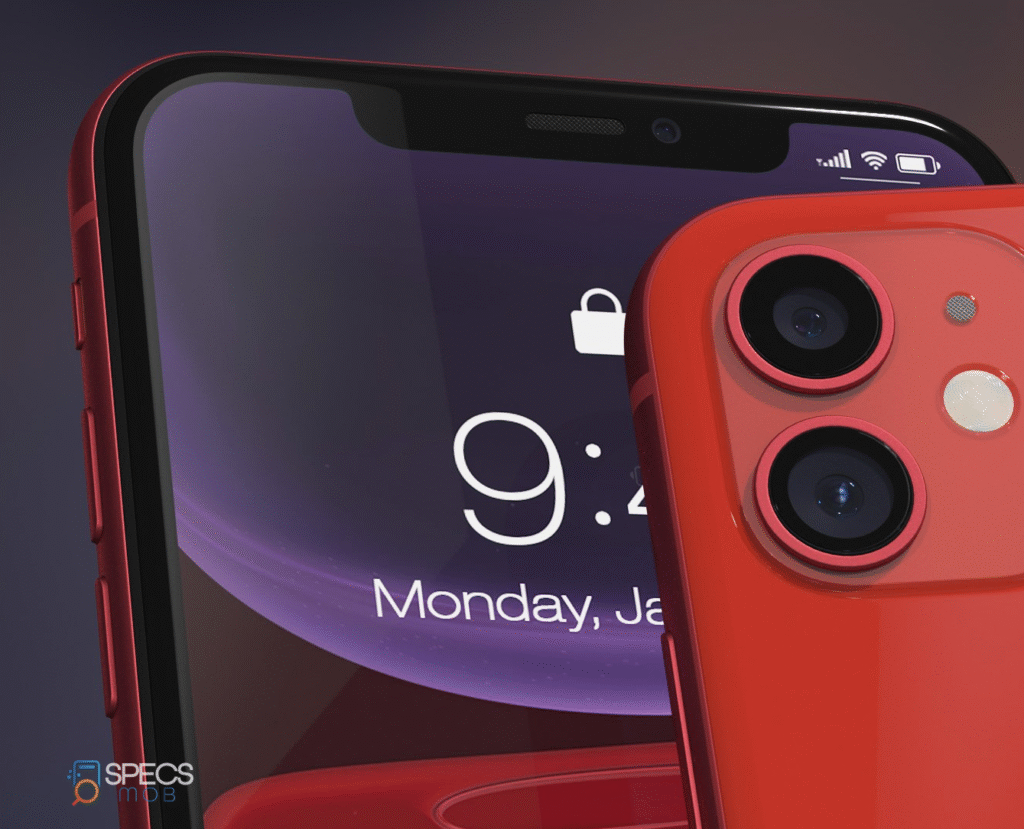
Battery Life
Slightly larger than the XR’s, the iPhone 11’s 3,110 mAh battery supports both wireless and 18W fast charging via USB Power Delivery. It includes a 5W charger, however, which only replenishes 18% of the battery in 30 minutes and may take as long as 4 hours to charge fully. An 18W fast charger enables a charge up to 55% in just 30 minutes. With an impressive endurance rating of 94 hours, the iPhone 11 surpassed the XR and 11 Pro in evaluations, providing 18 hours of 3G call time, 15. 5 hours for web surfing, and 18. 5 hours for video playback. Its efficient performance and standby time make it a strong contender for prolonged battery life.
Performance
The iPhone 11 is powered by the Apple A13 Bionic chip, which contains 8. 5 billion transistors and is built on a 7nm+ technology. It features an 8-core Neural Engine for advanced tasks such as Deep Fusion and Night Mode, a 4-core GPU (20% faster, 40% more efficient), and a hexa-core CPU (2×2. 65 GHz Lightning + 4×1. 8 GHz Thunder cores). Benchmarks confirm the A13’s superiority with 15% quicker single-core and 20% quicker multi-core performance compared to the A12. In offscreen evaluations such as Manhattan and Car Chase, the GPU also delivers top performance. The A13 surpasses Android competitors and establishes a high benchmark until the A14 is released due to its 4GB of RAM, improved thermal management utilizing graphene layers, and consistent performance with minimal throttling. It remains the fastest chip in smartphones.
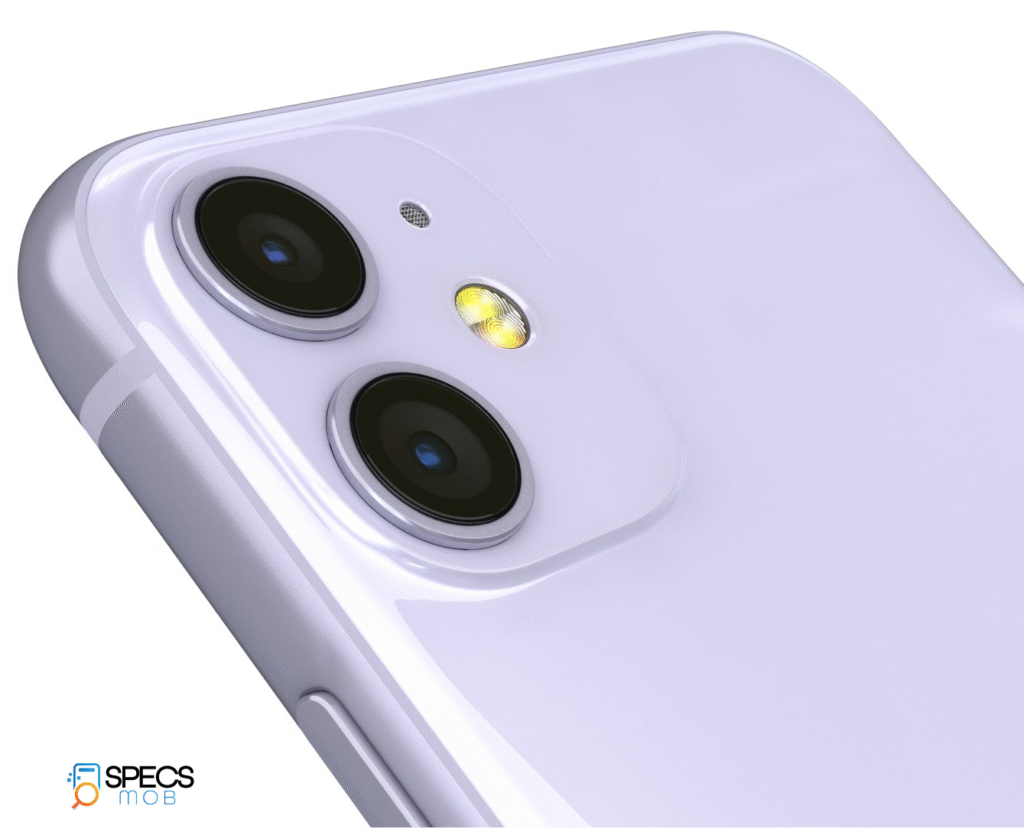
Summary
Building on the achievements of the iPhone XR, the iPhone 11 provides notable enhancements at a more affordable price. Exceptional performance is guaranteed by its 6. 1-inch LCD screen, dual 12MP camera setup (wide and ultra-wide), and powerful A13 Bionic processor. While it supports 18W fast charging, the battery (3,110mAh) delivers improved longevity, and the front 12MP camera records 4K video. Nevertheless, it is supplied with a 5W charger. The design includes fresh color choices, an aluminum frame, and IP68 water resistance. Although it does not support OLED or HDR, the display exhibits remarkable color precision. Taking everything into account, the iPhone 11 is a compelling choice for shoppers on a limited budget since it combines traditional iPhone characteristics with enhanced cameras, performance, and battery stamina.
Apple IPhone 11 Pro Review
Introduction
The smoothly functioning Apple marketing engine has returned to full swing in September. The iPhone 11 lineup was revealed at Apple’s iPhone event this autumn. Consequently, the iPhone XR has been phased out, substituted by the iPhone 11, the iPhone XS has been discontinued, and the iPhone 11 Pro has been introduced.
Similar to previous S generations, the iPhone XS series brought forth a new Bionic chip featuring a notable speed enhancement. Apple is prioritizing the camera with the iPhone 11 Pro series, which signifies the true meaning of the Pro label.
The highly efficient Apple marketing machine is operating at full capacity again in. If there was any doubt, the iPhone XS and iPhone XS Max were succeeded by the iPhone 11 Pro and 11 Pro Max. They share the same size, design, and display, but incorporate a new Apple U1 wideband chip, larger batteries, enhanced performance, and some notable camera modifications. Don’t be misled by the similar looks; there is a lot to explore.
Indeed, the front of the iPhone 11 Pro shows that the design has not changed. Nevertheless, the rear glass now features the frosted finish that we’ve appreciated since the OnePlus 6, along with a brand-new triple-camera setup on the back.The eleventh iPhone is now capable of enduring immersion in water up to four meters deep due to several advancements in water resistance.
The upgraded A12 Bionic chip from last year has been replaced by the new A13 Bionic chip. While it is largely derived from the A12 architecture, it also includes extra capabilities, such as a revised ISP and DSP.
However, the triple camera is a completely new component. There is now an ultrawide lens in addition to the wide and telephoto lenses. The iPhones finally include Night Mode, and the fantastic extended dynamic range is also incorporated into 4K 60fps recording. The capacity to utilize all four cameras (including the front-facing camera) at the same time may be the most extraordinary feature, highlighting the potential of Apple’s technology. @ 60 fps in 4K without any limitations. Just consider that!
Moreover, the highly anticipated update to the front camera has finally been released; it is currently a 12MP camera capable of capturing in all resolutions and frame rates, similar to the rear cameras. The front camera also supports slow-motion features, referred to as slofies, but it remains uncertain if these will ever be put into practice.
Furthermore, Apple has added a new Apple U1 wideband chip; however, iOS has not yet fully integrated its functionality.
In conclusion, the iPhone 11 Pro Max features a 25% boost in battery capacity compared to the XS Max, whereas the iPhone 11 Pro now possesses a 20% larger battery than the XS.
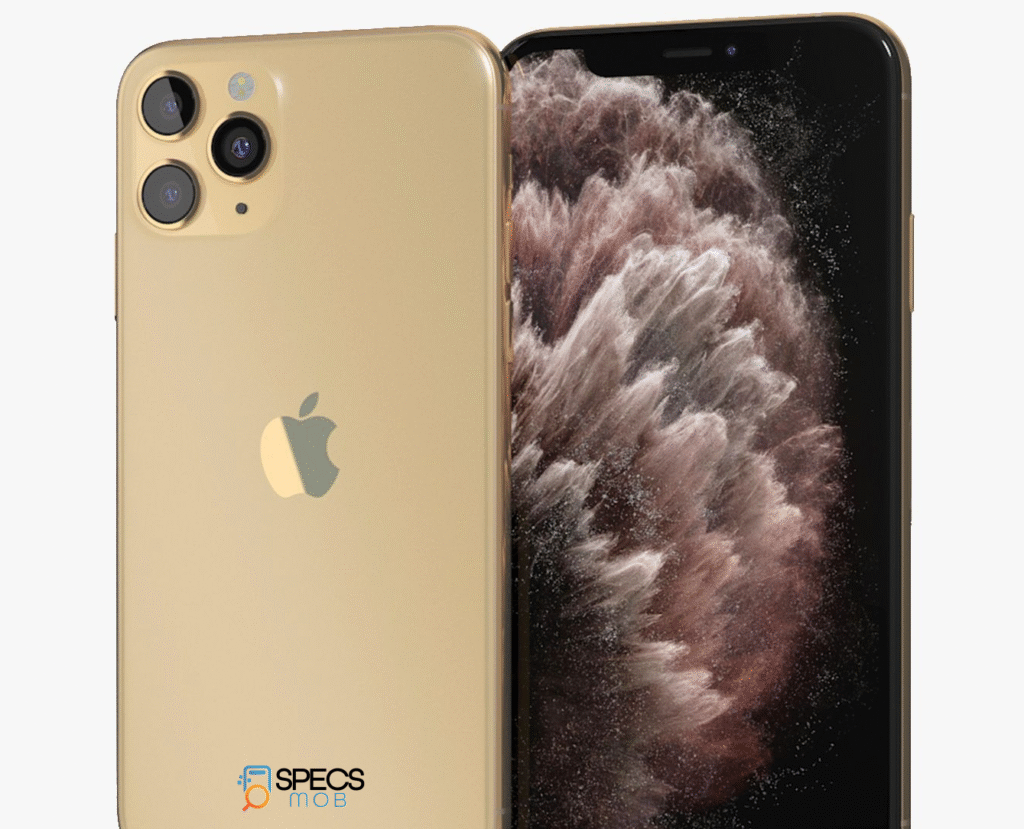
Specifications of the Apple iPhone 11 Pro and Pro Max
- Body: IP68 rated for dust and water resistance, stainless steel chassis, oleophobic-coated Gorilla Glass front, and a frosted Gorilla Glass back. Color options consist of Space Gray, Gold, Silver, and Midnight Green.
- Screen (Pro): 5. 8″ OLED display featuring 800 nits, 458 ppi, 120 Hz touch responsiveness, and a resolution of 1125 x 2436 px. Wide color gamut and support for HDR videos. A six-channel ambient light sensor is employed to adjust the tone.
- Screen (Pro Max): 6. 5″ OLED display with 800 nits, 458 ppi, 1242 x 2688 pixels, and 120 Hz touch responsiveness. Wide color gamut and support for HDR videos. A six-channel ambient light sensor is utilized to adjust the tone.
- Operating system: iOS 13
- Chipset: Hexa-core (2×2. 66 GHz Lightning + 4×1. 8 GHz Thunder) Apple A13 Bionic chip (7nm+) Three-generation Apple CPU, four-core Apple GPU, and eight-core Apple NPU
- 4GB of random-access memory and 64, 256, or 512GB of internal storage
- Triple 12MP camera: 13mm ultra wide-angle, F/2. 4, 120° FOV; 52mm telephoto, F/2. 0, OIS, 2x zoom; quad-LED flash with slow sync; 26mm main wide-angle, F/1. 8, OIS, Dual Pixel AF
- Video recording: OIS + EIS, 1080p@30/60/120/240 fps, 2160p@60/30 fps, featuring a greater dynamic range and spatial sound
- Selfie: EIS, depth detection for portrait mode, and a 23mm 12MP F/2. 2 front-facing camera with HDR mode and 3D TOF camera; 2160p@60/30 fps and 1080p@30/60/120 fps video recording featuring a greater dynamic range and spatial sound
- Connectivity features comprise Bluetooth 5. 0, a lightning connection, Wi-Fi a/b/g/n/ac/ax, dual SIM, and 4G LTE (1 Gbps); GPS with QZSS, GLONASS, GALILEO, and A-GPS; NFC; Apple U1 ultrawideband chip.
- Battery (Pro): Qi wireless charging, 18W fast charging, 3,046 mAh.
- 3,969 mAh battery with 18W fast charging and Qi wireless charging (Pro Max).
- Miscellaneous: Taptic Engine, dual speakers, and a specialized TrueDepth camera for Face ID.
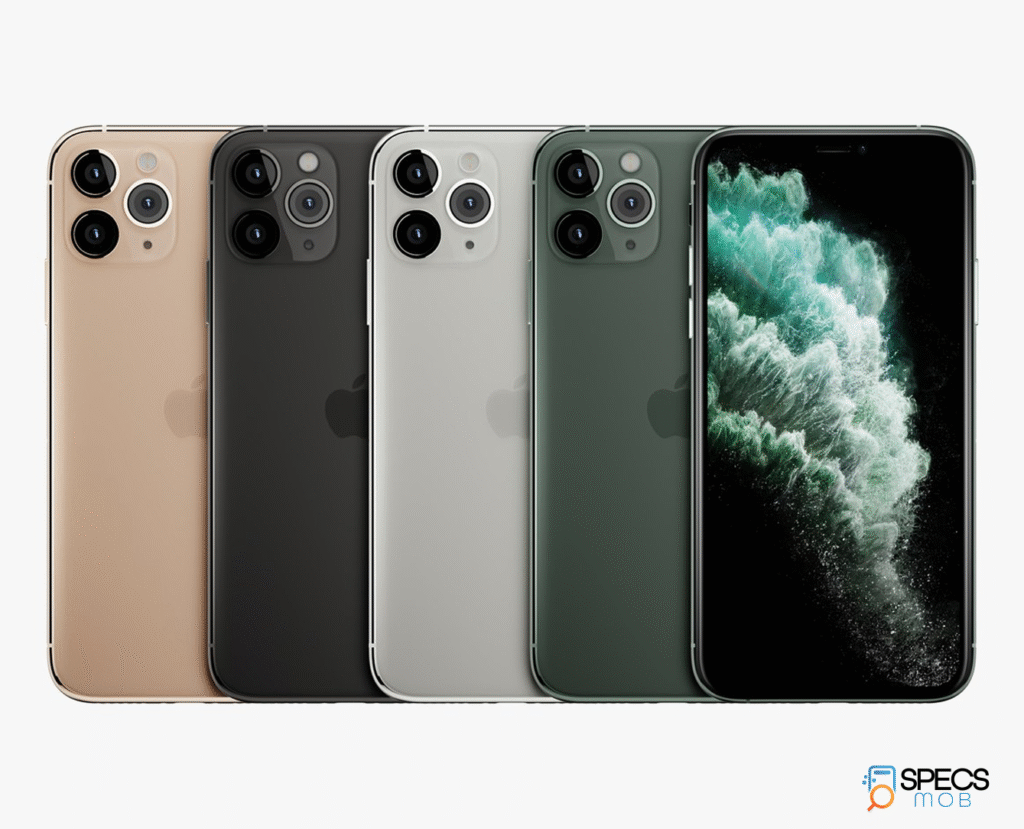
Apple’s 3D Touch period concluded with the arrival of the iPhone 11 Pro devices, and the Taptic Engine has taken its place. We cannot fault Apple for phasing out the 3D Touch technology, as it once held great promise but ultimately became a shortcoming of Apple itself, with innovation turning it into more of a hindrance. We would argue that it’s a mutually beneficial situation since it also created room for something more substantial, like a larger battery.
At the time this review was composed, an update to iOS 13. 1 had been released, and we had implemented it on all three iPhones. The iPhone 11 trio first launched operating on iOS 13. Among other features, it presents several new options that utilize the U1 chip.
A 5W charger, a USB cable, and a set of Apple headphones were part of the retail package for the original iPhone, which was launched in 2007 in an elegant black box. Additionally, while Apple did change the connector type and the shape of the pods, the components had not undergone major updates for more than 11 years. Now, this has changed.
The iPhone 11 Pro and 11 Pro Max are certainly the initial models to take advantage of Apple’s first-ever addition of an 18W fast charger in an iPhone retail package. The charger features 5V/3A and 9V/2A outputs along with an 18W rating. The Pro versions are the pioneering iPhones that come equipped with USB-C to Lightning cables due to the inclusion of a USB-C port on the top.
The famous EarPods, which come with a Lightning connector, are the last accessory found in the packaging of the iPhone 11 Pro and 11 Pro Max.
The 3.5mm adapter has not been part of the iPhone package since the iPhone XS series, and it continues to be missing from the iPhone 11 boxes.
Design
While making small yet noteworthy changes, the iPhone 11 Pro and 11 Pro Max keep the familiar design of their predecessors. Both versions feature slim bezels and the familiar notch that houses the 12MP selfie camera, 3D TOF sensor, and earpiece on their 5. 8-inch and 6. 5-inch OLED displays, respectively. The displays are protected by Corning’s “toughest glass,” which has surpassed previous models in drop tests. Although it is shiny and susceptible to fingerprints, the stainless-steel frame, available in coordinating colors like Midnight Green and Space Gray, adds to the premium feel.
The most prominent change is the first frosted matte glass back on the iPhone, which improves grip and reduces fingerprints. A completely new triple-camera setup with a 12MP wide, 12MP telephoto (both equipped with OIS), and a 12MP ultra-wide lens is also presented on the back. The glossy glass encircling the lenses provides a slight highlight, and the camera protrusion is less extensive than expected. When the iPhone text is removed, only the Apple logo is left.
The 11 Pro has a weight of 188g, which is 11g heavier than the XS, while the 11 Pro Max comes in at 226g, which is 18g more than the XS Max. Both models are slightly thicker and heavier compared to their previous versions. This added weight allows for larger batteries; the capacities of the 11 Pro and 11 Pro Max rise by 20% and 25%, respectively. Additionally, water resistance has been improved with an IP68 rating that allows for submersion up to 4 meters for 30 minutes.
Although the switch to USB-C is approaching, the Lightning port continues to exist. One-handed operation is made more stable by the textured back, enhancing grip, especially on the smaller 11 Pro. Even though it remains large, the Max variant is still most effective with two hands and gains from the enhanced finish.
With major enhancements such as the frosted back, better durability, and updated cameras, the iPhone 11 Pro series delivers a novel yet recognizable experience while maintaining the classic iPhone aesthetic.
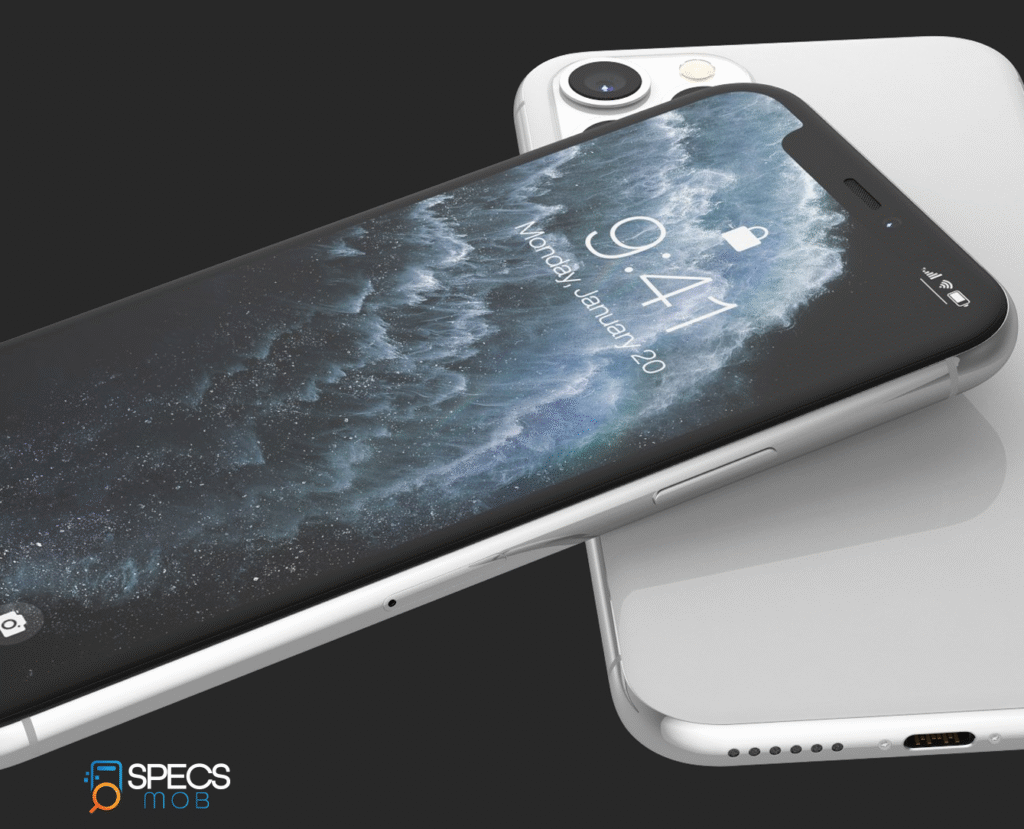
Display
With their XDR (eXtreme Dynamic Range) OLED screens, the iPhone 11 Pro and Pro Max offer significant improvements compared to previous models. These displays rank among the brightest and most vibrant available, featuring a contrast ratio of 2,000,000:1 and a peak brightness of 1200 nits (811 nits in manual mode). They ensure exceptional HDR performance by accommodating Dolby Vision and HDR10. With True Tone for accurate white balance and 120Hz touch input for seamless responsiveness, the 5. 8-inch and 6. 5-inch displays maintain a resolution of 458ppi. With an average DeltaE of 1. 6 (Pro) and 2. 4 (Pro Max) against sRGB and DCI-P3 standards, color precision is outstanding. These advancements grant the XDR panels remarkable brightness, contrast, and color precision, establishing them as a standout feature.
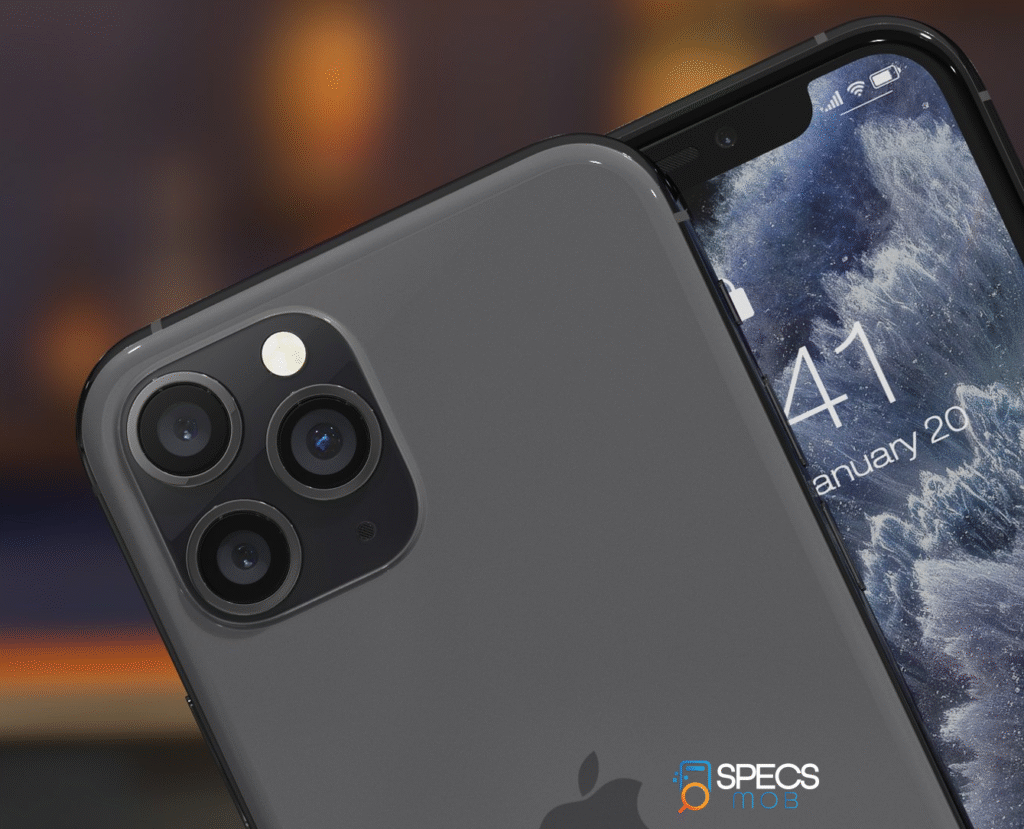
Battery Life
With a 3,969mAh capacity, the iPhone 11 Pro Max features Apple’s largest battery to date, which is 25% larger than the XS Max. An 18W fast charger comes with both Pro models, capable of recharging 50–58% in 30 minutes and requiring about two hours to reach a full charge. While reverse wireless charging was reportedly disabled due to overheating issues, they do support 10W wireless charging. Offering 21 hours of 3G conversations, 15 hours of web browsing, and 19. 5 hours of video playback, the Pro Max sets a new record for endurance, surpassing 100 hours in battery tests. Although the iPhone 11 Pro performs well in online and video assessments, its call and standby performance is average. Battery-aging enhancements are included in both models; however, disabling them might speed up charging at the cost of faster battery degradation.
Performance
The iPhone 11 Pro and Pro Max are powered by the Apple A13 Bionic chip, which consists of 8. 5 billion transistors and is built on a 7nm+ technology. It features an 8-core Neural Engine designed for sophisticated tasks such as Deep Fusion and Night Mode, along with a 4-core GPU (20% faster, 40% more efficient) and a hexa-core CPU (2×2. 65 GHz Lightning + 4×1. 8 GHz Thunder cores). Benchmarks confirm the A13’s superiority, showing 15% quicker single-core and 20% improved multi-core performance compared to the A12. In offscreen evaluations like Manhattan and Car Chase, the GPU demonstrates top performance as well. The A13 surpasses Android competitors and establishes a high benchmark until the arrival of the A14, thanks to its 4GB of RAM, improved thermal management using graphene layers, and consistent performance with minimal throttling. It remains the fastest chip in any smartphone.
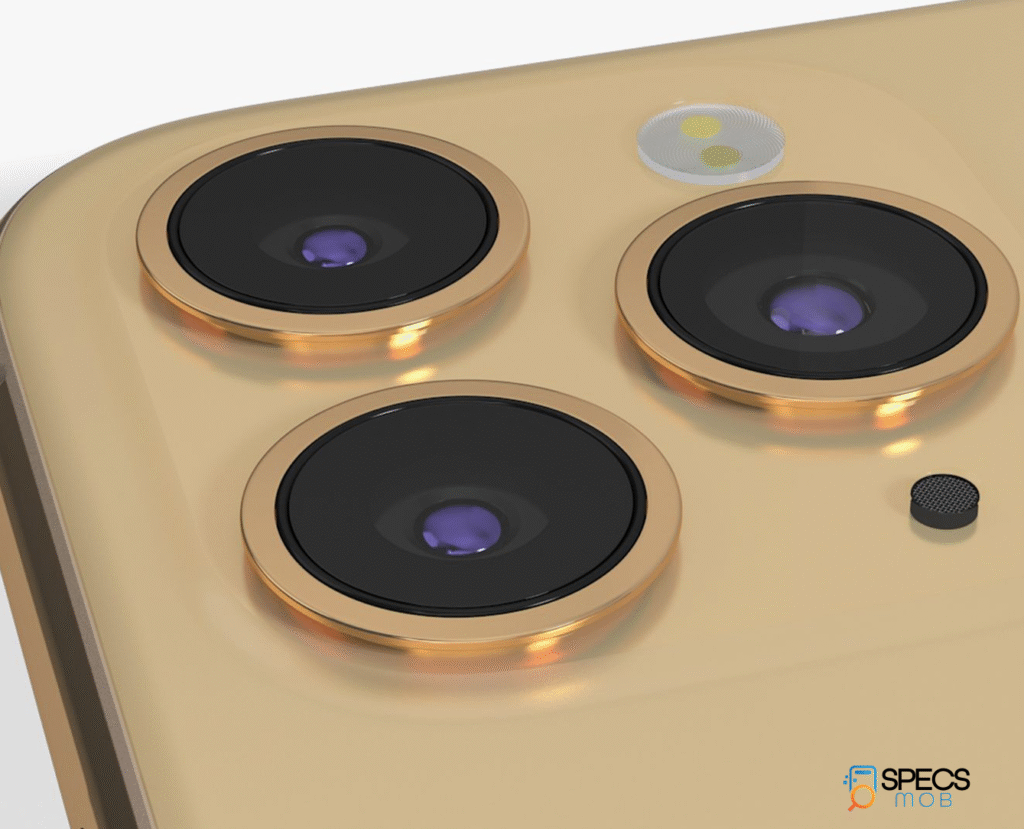
Summary
Featuring a triple-camera arrangement (wide, telephoto, and ultra-wide), a frosted matte glass back for enhanced grip, and the powerful A13 Bionic chip, the iPhone 11 Pro and Pro Max provide significant advancements compared to their earlier versions. Both devices include True Tone for precise color reproduction, HDR10/Dolby Vision support, and XDR OLED displays with a peak brightness of 1200 nits. Thanks to its record-setting endurance rating and 3,969mAh battery, the Pro Max can facilitate 3G calls for as long as 21 hours. IP68 water resistance has seen enhancements (4m for 30 minutes). They support 10W wireless charging and 18W fast charging, even though they still incorporate the Lightning port. The A13 chip stands as the quickest smartphone processor available, boasting 20% improved CPU and GPU performance.
You must be logged in to post a review.
Launch
Announced
Status
2021-04-30
Available
Performance
Operating System
Chipset
CPU
GPU
iOS 18, upgradable to iOS 18.3.2
Apple A18 Pro (3 nm)
Hexa-core (2x4.05 GHz + 4x2.42 GHz)
Apple GPU (6-core graphics)
DESIGN & BUILD
Dimensions
163 x 77.6 x 8.3 mm (6.42 x 3.06 x 0.33 in)
Weight
227 g (8.01 oz)
Build
Glass front, glass back, titanium frame (grade 5)
Durability
Glass front, glass back, titanium frame (grade 5)
Display
Type
LTPO Super Retina XDR OLED, 120Hz, HDR10, Dolby Vision, 1000 nits (typ), 2000 nits (HBM)
Screen Size
1320 x 2868 pixels, 19.5:9 ratio (~460 ppi density)
Resolution
1320 x 2868 pixels, 19.5:9 ratio (~460 ppi density)
Protection
Ceramic Shield glass (2024 gen) Always-On display
Network & Connectivity
SIM Support
Glass front, glass back, titanium frame (grade 5)
Network Bands
Glass front, glass back, titanium frame (grade 5)
Wifi
Glass front, glass back, titanium frame (grade 5)
Bluetooth
5.3, A2DP, LE
Navigation Systems
Glass front, glass back, titanium frame (grade 5)
USB Interface
Glass front, glass back, titanium frame (grade 5)
Camera Capabilities
Rear Camera Setup
1320 x 2868 pixels, 19.5:9 ratio (~460 ppi density)
Rear Camera Features
1320 x 2868 pixels, 19.5:9 ratio (~460 ppi density)
Rear Video Recording
1320 x 2868 pixels, 19.5:9 ratio (~460 ppi density)
Front Camera Setup
1320 x 2868 pixels, 19.5:9 ratio (~460 ppi density)
Front Camera Features
1320 x 2868 pixels, 19.5:9 ratio (~460 ppi density)
Front Video Recording
1320 x 2868 pixels, 19.5:9 ratio (~460 ppi density)
Memory
RAM
1320 x 2868 pixels, 19.5:9 ratio (~460 ppi density)
Storage
1320 x 2868 pixels, 19.5:9 ratio (~460 ppi density)
MemorySlot
1320 x 2868 pixels, 19.5:9 ratio (~460 ppi density)
Audio
Speaker System
Yes, with stereo speakers
3.5mm Jack
No
Features
Sensors
Face ID, accelerometer, gyro, proximity, compass, barometer Ultra Wideband (UWB) support (gen2 chip) Emergency SOS, Messages and Find My via satellite
Radio
NO
Torch
Yes
Battery
Type
Li-Ion 4685 mAh
Charging
Wired, PD2.0, 50% in 30 min 25W wireless (MagSafe), 15W wireless (China only) 15W wireless (Qi2) 4.5W reverse wired
Talk Time
Music Play
MISC
Colors
Black Titanium, White Titanium, Natural Titanium, Desert Titanium
Models
A3296, A3084, A3295, A3297, iPhone17,2
Price
$ 1,019.90 / € 1,253.99 / £ 1,024.99
Disclaimer. Although we aim to provide accurate information, we cannot ensure that all content on this page is completely correct



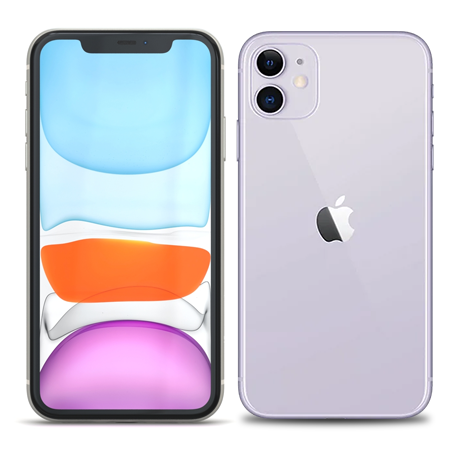
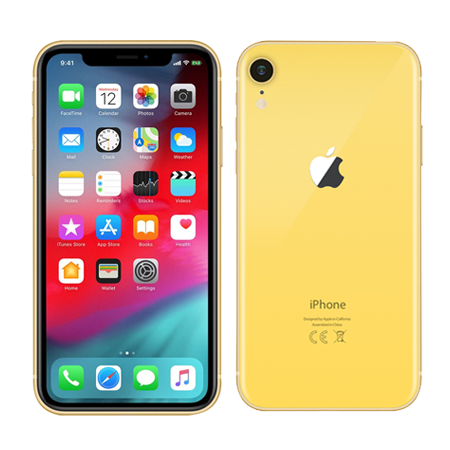

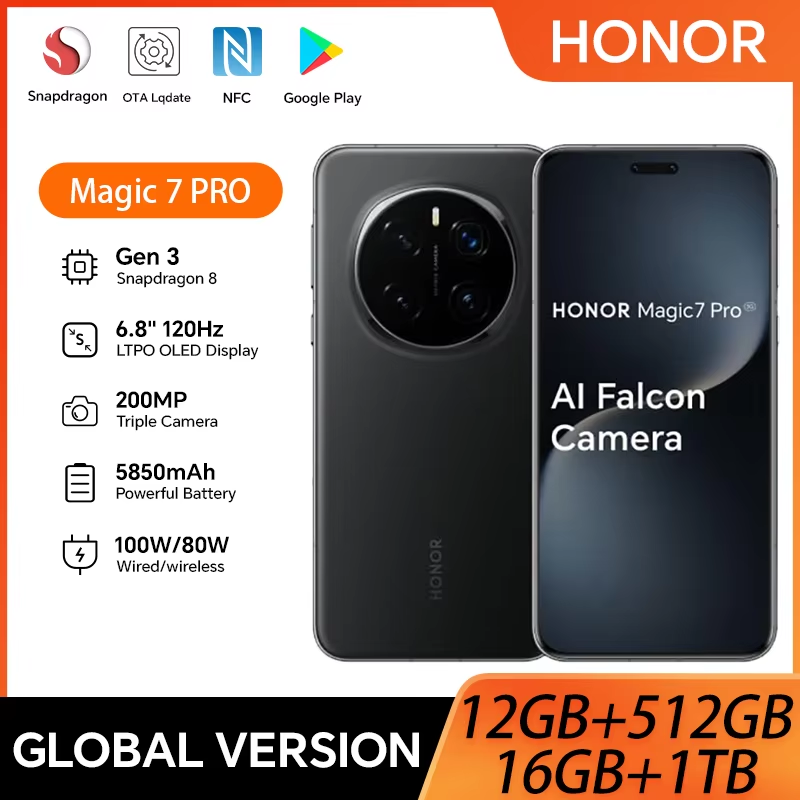


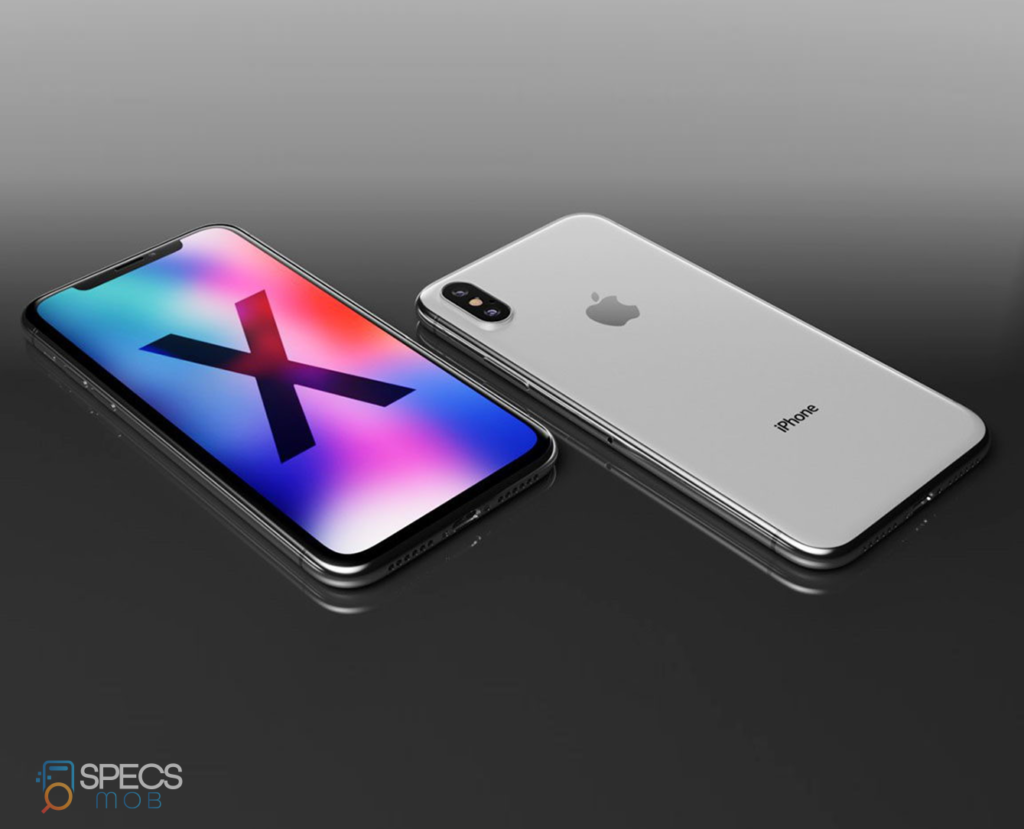

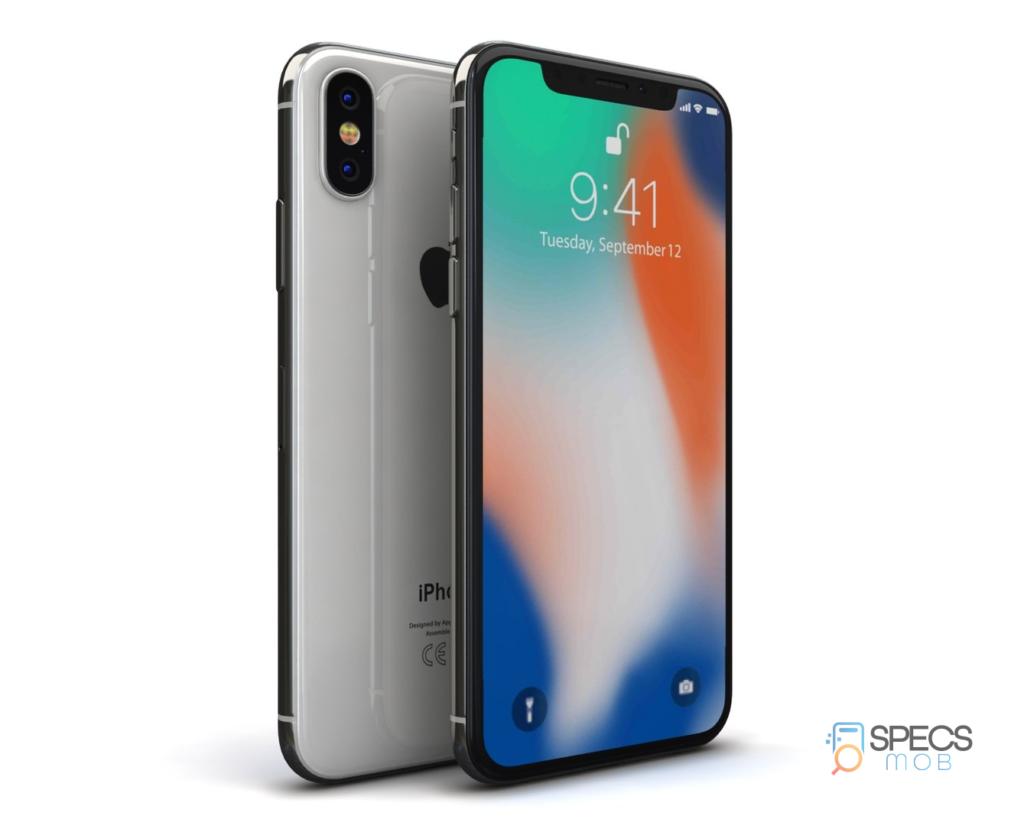
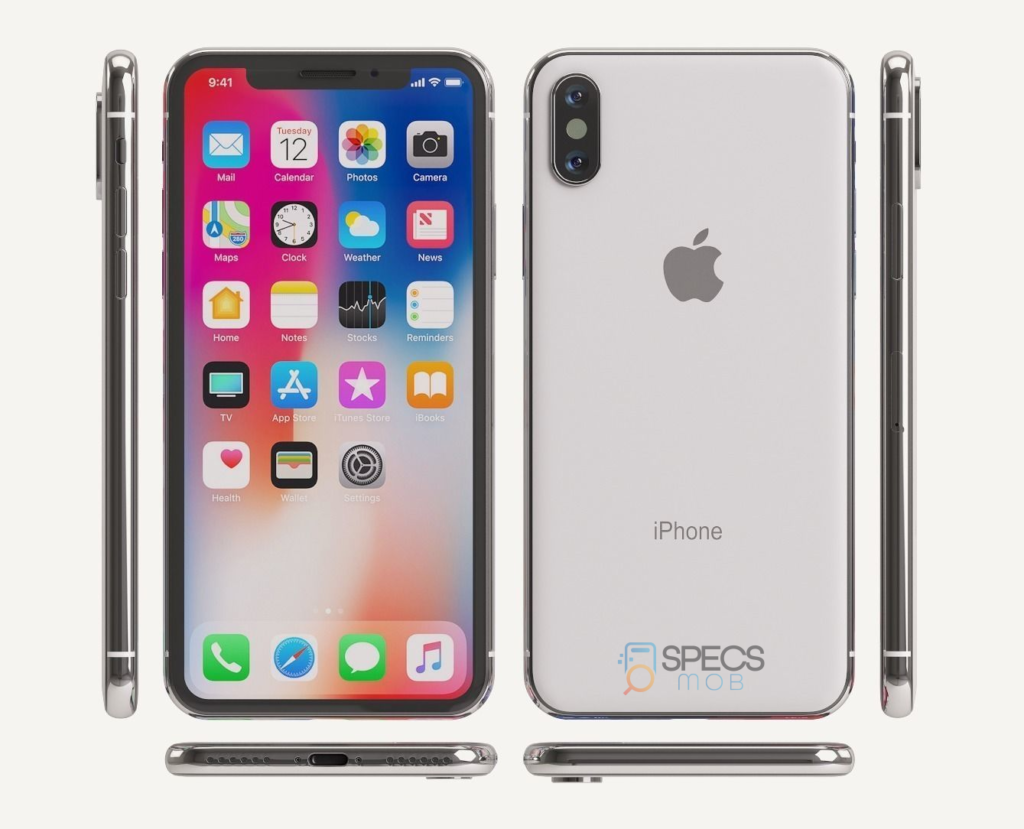
Reviews
There are no reviews yet.